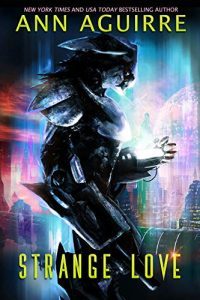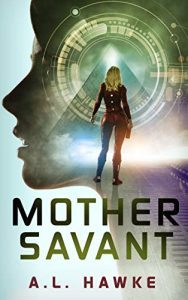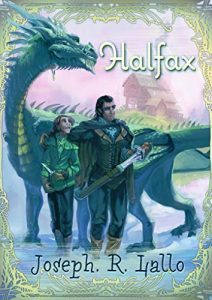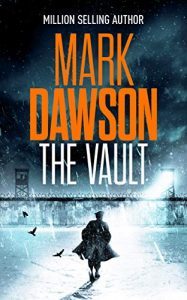Cora Buhlert's Blog, page 63
February 2, 2020
Retro Review: “Morgue Ship” by Ray Bradbury
[image error]“Morgue Ship” by Ray Bradbury is a science fiction short story, which appeared in the summer 1944 issue of Planet Stories and is therefore eligible for the 1945 Retro Hugos. The story may be found here. This review will also be crossposted to Retro Science Fiction Reviews.
Warning: There will be spoilers in the following!
Sam Burnett is one of two living humans aboard the Constellation, the titular morgue ship, which picks up the dead of an interplanetary war between Earth and Venus and then returns the bodies to Earth. The ship has room for one hundred bodies and Burnett has just picked up body number ninety-eight of his one hundredth run. It will also be his last, for Burnett is burned out both by the sheer amount of death he’s seen and also by the fact that instead of wartime heroics, Burnett and the morgue ship only arrive when the war has already moved on.
Body number ninety-eight turns out to be a Venusian officer named Lethla, the righthand man of the Venusian commander Kriere. Burnett’s younger and less jaded partner Rice is excited by this find, for if Lethla is aboard the morgue ship and dead, then Kriere must be close by and perhaps injured or dead as well. Retrieving Kriere might well end the war and make Burnett and Rice heroes. However, Burnett dampens his young partner’s enthusiasm. The war has long since moved on and Lethla is just another body to be retrieved and prepared.
There is just one problem. Lethla isn’t dead. He suddenly sits up on the morgue slab, draws his gun and points it at Burnett and Rice, both of whom are unarmed. Turns out that that he survived because of a thin glass mask and oxygen capsules (the requirements of surviving in the vacuum of space were not yet well known). Lethla then proceeds to destroy the radio of the Constellation and demands that Rice and Burnett help him rescue his superior Kriere. For the ship carrying Lethla and Kriere was attacked and destroyed. Lethla and Kriere managed to survive in a liferocket (the term “escape pod” wouldn’t be coined until much later), but they had neither a radio nor sufficient supplies. The morgue ship is their best chance of getting past the Earth blockades back to Venus.
Rice is something of a hothead and attempts to defy Lethla, but Burnett seemingly goes along with Lethla’s orders, while plotting to capture both Lethla and Kriere and thus end the war. When they spot Kriere’s floating body, Burnett leaves the controls of the Constellation to Rice and operates the morgue ship’s retrieval claw to pull in Kriere – body number ninety-nine.
However, Burnett deliberately lets the retrieval claw grip Kriere too tightly, crushing and killing the Venusian. The death of his commander shocks Lethla long enough that Burnett and Rice can attack him. Together, they manage to disarm and kill Lethla, but not before Burnett is shot.
Burnett dies, knowing that he has ended the war and that there will be no more morgue ship trips necessary. He becomes body number one hundred of the last cargo of the Constellation.
When thinking of Planet Stories – home of space opera adventure and planetary romance – Ray Bradbury is not the first author who comes to mind, even though he wrote a fair number of stories for the magazine, three in 1944 alone. Many of the stories that would eventually make up The Martian Chronicles were also first published in Planet Stories.
“Morgue Ship” manages to be both a typical Planet Stories yarn and a typical Ray Bradbury story. It has all the space action, adventure and suspense one expects to find in Planet Stories and it has the poetic style and introspective melancholia one expects from a Ray Bradbury story.
Few authors of the golden age have the command of language that Ray Bradbury had. Mostly, speculative fiction of the golden age either features the invisible prose found in Astounding or the overly purple prose often associated with Weird Tales under Farnsworth Wright. Not many authors managed to find a golden means between those two extremes, but Bradbury is one of them.
“Morgue Ship” is short, only six pages long (and half a page is taken up by an illustration), but Bradbury perfectly manages to capture the atmosphere aboard the morgue ship with its clinical interior, its shelves full of dead soldiers, the churning blood pumps and whirring machinery, in such a short space. Bradbury also manages to pack the horrors of war in space, the exploding ships and spinning dead bodies among the wreckage, into just a few paragraphs. Finally, Bradbury captures overwhelming weariness of Sam Burnett, weariness with his grisly task, weariness with the war and the feeling that because Burnett is not a combatant, he is not contributing to the war effort.
This last sentiment is something that I have occasionally encountered on the Allied side of World War II, mainly among Americans who were either not fit for active military service or on assignments far from the frontlines and yet yearned for frontline action. On the German side, there also are plenty of accounts of mostly very young boys eager to fight and die for Führer and Fatherland (and by the end of World War II, the Nazis were drafting boys of sixteen and younger, many of whom did not survive), but just as many accounts by mostly somewhat older men, many of whom still remembered World War I and tried to avoid being sent to the frontline by all possible means. In fact, relatively safe posts far from the frontlines were often handed out as rewards for “solid” citizens, while particularly dangerous frontline assignments were viewed as a way of getting rid of malcontents and shutting up problematic people.
“Morgue Ship” was written and published, while World War II was still going on, so the desire of Burnett and Rice to finally get to take part in the action rather than picking up the pieces afterwards is understandable in the context of the time. Furthermore, men of fighting age, who were not in active service, were often treated with contempt or outright hostility on both sides of World War II. “Morgue Ship” is clearly an attempt to show that non-combatants also serve and are vital for the war effort. And since Ray Bradbury was not in the military during World War II (he was rejected for medical reasons), I also wonder whether he did not have first hand experience with the contempt for and hostility towards young male non-combatants at the time.
Though much of the so-called golden age of science fiction coincided with World War II, comparatively few stories of the time reference the war. Of the 1944 Retro Hugo finalists in the fiction categories, the two works that actually reference the war – The Magic Bedknob; or, How to Become a Witch in Ten Easy Lessons by Mary Norton and to a lesser degree The Little Prince by Antoine de Saint-Exupéry – are both outliers from outside the American science fiction scene. “Morgue Ship” is one of the very few science fiction stories published in the American pulp magazines of the time that address the war at least indirectly.
As I’ve remarked before, Ray Bradbury’s stories are the most timeless of the various Retro Hugo finalists and Retro Hugo eligible stories I have reviewed over the years. Some of the technical details in “Morgue Ship” are dated, but with a few edits the story wouldn’t feel out of place in a contemporary issue of Uncanny or Tor.com or Lightspeed or Clarkesworld.
Isaac Asimov and Ray Bradbury were almost the same age (both born in 1920, though Asimov’s exact birthdate is not known) and started publishing around the same time, though Asimov managed to break into the pro magazines before Bradbury did. However, the three Asimov stories I reviewed show that Isaac Asimov was still very much developing as a writer at this point in his career, while Ray Bradbury’s writing skills are much further along.
In Zen in the Art of Writing, Bradbury wrote that the 1944 Retro Hugo winner for Best Short Story “R is for Rocket” as well as “The Lake”, which I reviewed here, were his breakthrough stories, where he stopped trying to imitate other writers and also stopped writing what he believed magazine editors wanted and finally found his own voice. “Morgue Ship” dates from the same period and is another example of Bradbury finding his own voice and style. For “Morgue Ship” is very unlike most stories from this period. In fact, the story of which “Morgue Ship” reminded me most is “Aftermaths” by Lois McMaster Bujold (nowadays included in Shards of Honor as a sort of epilogue), which was first published in 1986, more than forty years after “Morgue Ship”.
“Morgue Ship” is not nearly as well known as either “The Lake” or “R is for Rocket” and in fact had never been reprinted until the 2010s in the three volume The Collected Stories of Ray Bradbury: A Critical Edition. This is unfair, because “Morgue Ship” is a great story that shows just how good a writer Ray Bradbury already was at the age of barely twenty-four.
In fact, “Morgue Ship” is probably the most pleasant surprise I’ve had since I started the Retro Science Fiction Reviews project. For I already knew that “The Lake” and the Leigh Brackett stories were good. “Morgue Ship”, on the other hand, was completely unknown to me and turned out to be an unjustly forgotten gem.
 Send to Kindle
Send to Kindle
First Monday Free Fiction: Valentine’s Day on Iago Prime
[image error]Welcome to the February 2020 edition of First Monday Free Fiction. To recap, inspired by Kristine Kathryn Rusch who posts a free short story every week on her blog, I’ll post a free story on every first Monday of the month. It will remain free to read on this blog for one month, then I’ll take it down and post another story.
February 14 is Valentine’s Day, so what could be more fitting than to post Valentine’s Day on Iago Prime, one of two Valentine’s Day stories I’ve written.
So follow newly-weds Maisie and Kai, as they prepare to celebrate…
Valentine’s Day on Iago Prime
It would be Maisie and Kai’s first Valentine’s Day on the newly settled Earth colony of Iago Prime.
Of course, on Iago Prime a year was only two hundred and sixty two days long. But for religious and traditional holidays, the colonists still adhered to the old Earth calendar, even if it meant that Valentine’s Day fell into the middle of summer — or at least what passed for summer here on Iago Prime.
Back on Earth, Maisie and Kai Jones — together for more than six years now and married for one and a half, mostly to fulfill the outdated requirements of the colony settlement board — had always celebrated Valentine’s Day by having a picnic on the beach.
Of course, February wasn’t the ideal time for a romantic picnic on the beach at all, not when the beach was in Wales rather than California. But it was the tradition that Maisie and Kai had established for themselves and they were determined to stick to it, even if it meant shivering together on a blanket in Aberystwyth, eating sandwiches and drinking champagne from plastic cups and hot tea from a thermos.
Kai and Maisie had met, when they were both students at the University of Cardiff, she of communication science and he in the engineering department. They shared a beer at the student union and bonded over their shared dream to go out into space one day, to become pioneers, the first humans to set foot onto a brand new world.
However, in those days, space had seemed very far away indeed, even if the university campus was plastered with recruitment posters for the colony settlement board, all of them showing intrepid pioneers posing in front of awe-inspiring alien landscapes, calling out to all those students who felt that Wales was so suffocating that they’d even board an interstellar spacecraft to escape.
And so for their first date — during the height of summer in the Northern hemisphere — Kai and Maisie drove to the seaside town of Aberystwyth instead. They took the vintage funicular railway up Constitution Hill, enjoyed the view and visited the equally vintage camera obscura, stunned that both the railway and the camera obscura were both lovingly maintained and still functional after almost three hundred years. They duly admired the vintage machinery and marvelled at the artistry of people who hadn’t even developed moving pictures yet, let alone lasers and holograms and flight and space travel. Afterwards, they had a picnic on the beach — with sandwiches and salad and a cheap bottle of wine. And finally, they’d enjoyed a night of hot and sweaty sex in one of the historical bed and breakfasts along the promenade.
It had been a truly magical day, so magical that Kai had decided to recreate it for their first Valentines Day together. Of course, neither the funicular railway nor the camera obscura were open in February — three hundred year old antiques apparently did not like winter, even if they were meticulously restored. So Kai and Maisie had simply settled for a picnic on the beach and a night spent at a bed and breakfast. And thus a tradition was born.
When Kai and Maisie got married shortly before disembarking for Iago Prime, they celebrated on Constitution Hill and had a big combined wedding and good-bye party for all their friends and family. They also had their photo taken in front of the funicular railway, Kai in a stiff black suit and Maisie in the traditional white gown with the traditional veil fluttering in the wind. The photo now sat in a silver frame on the nightstand of the rather utilitarian quarters they shared, a cheerful reminder of the world and the life they had left behind.
***
Iago Prime was one of the few places in the known universe that managed to be even more unpleasant than Aberystwyth in February. It was rocky all over without a single trace of vegetation. The oceans here were blubbering hellholes of liquid ammonia. The atmosphere was poisonous and even at the height of summer, the temperatures rarely cleared minus forty degrees Celsius, which made it officially colder than Wales in midwinter. In short, Iago Prime was not just the sort of world where only the really enthusiastic and/or desperate pioneers would go, it was also about the only spot in the known universe that was less suited to a Valentine’s Day picnic than Aberystwyth.
For major holidays, the colony management always organised an official celebration in the central cafeteria of the compound. But what was fine for Christmas or Easter or Halloween or Carnival or Passover or Chanukah or Diwali or Eid al-Fitr or Lunar New Year was not necessarily what you wanted for Valentine’s Day. Cause honestly, who wanted to have a romantic dinner for two — together with all the other people on the base and their respective life partners?
Never mind that there would be neither roses — the hydroponic garden was needed for more essential things such as vegetables to feed the colony — nor candlelight, candles being considered both an air pollutant and a fire hazard. There wouldn’t even be any wine, let alone champagne, for alcohol and the hazardous environment of an unterraformed world did not mix.
In short, Valentine’s Day on Iago Prime was about as unromantic as it was possible to get. Of course, both Maisie and Kai had known that they’d have to give up most of the comforts of home when they signed up for the colony settlement advance team. But no one had told them that they’d have to give up romance, too.
So Kai wrecked his brain, trying to come up with a way to give Maisie an unforgettable Valentine’s Day even within the confines of what the colony on Iago Prime allowed. For several days and nights he pondered. Then he had an idea.
He studied maps and models of the planet, talked to a member of the geological survey team, requested a shift change from the colony manager for Maisie and himself and even bribed the provisions officer as well as the man who was in charge of the colony’s vehicle pool. In short, Kai called in every favour that he could and a few that would be hard to repay. Operation: Valentine’s Day was a go.
***
On Valentine’s Day early in what passed for morning in the perpetual gloom of Iago Prime, Kai woke Maisie and led her to the ground vehicle hangar.
“All right, you said you had a surprise for me,” Maisie exclaimed. She looked around the hangar, which looked like it always did, barren and utilitarian. “So where is it?”
“Right here.” Kai pointed at a Rover, one of the ground survey vehicles used by the colonists. “Time for a road trip.”
“Road trip?” Maisie repeated, “But my shift in the com centre starts in twenty-five minutes and I’m not even properly dressed yet.”
“Forget it,” Kai said, “Kamala is taking over your shift today, while you’ll take over hers for her birthday next month.”
“But what about your shift?”
“I swapped shifts with Rashid, so we’ve got ten blessed hours of free time.”
“What about that Valentine’s dinner and dance at the central cafeteria tonight?” Maisie wanted to know.
“Do you really want to go there? You, me and every other couple in the entire colony?”
“Not particularly, no.” Maisie shrugged. “But that’s the way they do things here and it was nice of the colony management to set everything up. I hear they even programmed the holo-projectors to display hearts and roses and the kitchen team have prepared a special meal and afterwards, Tetsuo Watanabe will play romantic songs on his violin.”
“I’ve heard enough of Tetsuo and his violin to last me a lifetime.” Kai reached for Maisie’s hand. “I’d much rather be alone with you.”
“Me, too, but that’s just not possible here. And we both knew what we were getting into…”
“Of course it’s possible,” Kai said, “Like I said, we’re going on a road trip.”
“But Iago Prime doesn’t even have any roads,” Maisie stammered, “And besides, where will we go?”
“You’ll see.” Kai opened the door of the Rover. “Look, I even brought a picnic basket.”
He picked up two geological sample cases that were now filled with sandwiches and soy meatballs and salad jars and canned drinks that he’d bribed the provisions officer to provide in exchange for extra com time with his family on Earth.
“But how can we possibly have a picnic…” Maisie wanted to know, “…when it’s minus forty degrees Celsius outside and the atmosphere is so toxic that we can’t even breathe?”
“That’s why we’ll bring our pressure suits, too,” Kai said. He walked over to a row of lockers along one wall of the hangar, fetched their respective suits and handed the smaller of the two bulky suits to Maisie. “Time to get suited up.”
It took them only a few minutes to put on their suits. The hostile atmosphere of Iago Prime and the daily emergency drills at the compound had given them both plenty of practice.
When they were both suited up, Kai pointed at the open passenger door of the Rover and executed a gallant bow or at least as gallant as he could manage in his bulky pressure suit.
“And now hop inside, so we can get going.”
***
The drive through the rocky terrain of Iago Prime took them maybe two hours, about the same time the annual trip to Aberystwyth had taken them back home. And since Kai had fed the Rover’s navigation computer with all sorts of data gleaned from the geological survey team, they didn’t even get lost. And considering that Maisie had always teased him about his appalling sense of direction back on Earth, not getting lost on an alien planet that had neither roads nor road signs was quite an achievement.
After all, Kai had even managed to get lost during their first trip to Aberystwyth some six years ago now. Somehow, he’d taken a wrong turn at Libanus that had taken them deep into the Brecon Beacons National Park. And unlike Iago Prime, Wales actually had roads and road signs, even if half of them were in Welsh only.
But thankfully, the geological survey team knew their stuff and so the navigation computer directed them safely to their destination. The Rover rounded a rocky cliff and finally came to a halt upon a gently sloping hill, at least by Iago Prime standards.
“We’re here,” Kai said and sealed his helmet.
When Maisie had sealed her helmet as well and they had depressurised the Rover, Kai opened the doors and they both stepped out onto the hill, their boots sinking into the black lava sand.
“Okay, I’ll bite,” Maisie said via the suit com, “Why did we come here rather than to any of the other five billion rocky plateaus scattered around the planet?”
Kai didn’t answer. He just took a step forwards and then another, up the hill. Her curiosity aroused, Maisie followed him.
They walked maybe a hundred meters, the steep incline of the hill and the weight of their suits offset by the lower than Earth standard gravity on Iago Prime. And then they came to the edge of the bluff, looking down on sea-green waves of liquid ammonia crashing against the rocks about a hundred metres below. It was almost as if they were back on Constitution Hill, looking down on Cardigan Bay, if not for the unfamiliar stars and constellations dotting the skies above.
“Oh my God,” Maisie exclaimed, “It’s the beach. We’re on the beach.”
“This was the closest thing to a beach I could find within reasonable distance of the compound,” Kai replied, “I know it’s not Aberystwyth, but…”
“It’s beautiful,” Maisie said, squeezing Kai’s gloved hand with her own, “It’s absolutely perfect. And anyway, if I’d wanted Aberystwyth forever, I would have stayed on Earth.”
Hand in hand they stood at the edge of the cliff, watching the curiously hypnotic spectacle of burbling waves crashing against the cliffside through a haze of sea spray created by liquid ammonia evaporating in the wan sun.
After a few minutes, Maisie leant towards Kai, until the faceplates of their helmets touched, as close to a kiss as they could come in the hostile environment of Iago Prime.
“Thank you,” Maisie whispered, her voice barely audible over the static crackle of the suit com, “Thank you for a wonderful Valentine’s Day.”
“Ah well,” Kai said, blushing inside his suit, “I had to do what I could to salvage our Valentine’s Day tradition, didn’t I? Though I fear we’ll have to have our picnic inside the Rover this year, cause the temperature and the air out here are absolutely murderous.”
“And afterwards…” Maisie flashed him the secret smile that was reserved only for him. “…maybe we can get rid of those bulky suits as well. Cause I don’t think there’s a B and B anywhere around here, so we’ll just have to make do.”
The End
***
That’s it for this month’s edition of First Monday Free Fiction. Check back next month, when a new story will be posted.
 Send to Kindle
Send to Kindle
January 30, 2020
Retro Review: “Catch That Rabbit” by Isaac Asimov
[image error]“Catch That Rabbit” is a short story by Isaac Asimov, which was first published in the February 1944 issue of Astounding Science Fiction and is therefore eligible for the 1945 Retro Hugos. The magazine version may be found online here. “Catch That Rabbit” has also been widely reprinted in I, Robot, The Complete Robot and other Asimov robot collections. This review will also be crossposted to Retro Science Fiction Reviews.
Warning: Spoilers beyond this point!
“Catch That Rabbit” is one of five stories Asimov wrote about Mike Donovan and Gregory Powell, a pair of troubleshooters in the employ of United States Robots and Mechanical Men Inc. “Catch That Rabbit” is also the last of the Powell and Donovan stories except for “First Law”, a 1956 “tale told in a bar” story that Asimov himself has called a spoof and the 1945 short story “Escape”, wherein Powell and Donovan work with and are upstaged by Dr. Susan Calvin.
In “Catch That Rabbit”, Powell and Donovan are tasked with field-testing DV-5, a robot of US Robots’ brand-new line of mining robots. What makes DV-5 – or “Dave”, as Powell and Donovan call him – special is that he controls six smaller robots via his positronic field. What’s a positronic field? Don’t ask, cause Powell and Donovan have no idea and neither does Asimov. However, the smaller robots are not independent, instead Powell and Donovan liken them to the fingers of a human body.
Dave passed all factory tests with flying colours. But when he is deployed on an asteroid for field tests, along with Gregory Powell and a grumbling Mike Donovan, Dave and his “fingers” sometimes fail to mine any ore at all. Worse, Dave can’t or won’t explain what the problem is. Instead, he claims he can’t remember what happened.
In my review of “The Big and the Little”, I said that many of Asimov’s early stories – both robot and Foundation stories – are structured like mysteries. But instead of figuring out whodunnit, the investigators are tasked with figuring out why a robot malfunctioned. “Catch That Rabbit” is an excellent example, because it is essentially a science fiction mystery with Powell and Donovan trying to figure out what the blazes is wrong with Dave.
Gradually, the clues pile up. For starters, Dave only malfunctions, when neither Powell nor Donovan are around. This, of course, makes it difficult to figure out what is wrong. Tests reveal no problem with Dave’s positronic brain. Questioning Dave doesn’t help either, because Dave claims amnesia, though Donovan at least is sceptical about the veracity of his claims. But then, Donovan is given to panic and wild speculations, whereas Powell is much more practical.
Gregory Powell comes up with the idea to install a kind of viewscreen, called “visiplate” in the story, so they can remotely watch what Dave and his subordinates are doing. And so one day while they are bickering (and Powell and Donovan bicker a lot), they spot Dave making his subordinates march up and down the mine tunnels in a military formation. Donovan worries that this might be a prelude to the robot revolution, but Powell assures him that this is impossible and uses the opportunity to remind Donovan and the reader of the Three Laws of Robotics.
When our dynamic duo heads out to the mining site, the robots promptly return to normal, once they detect the presence of Powell and Donovan. Worse, Dave once more claims to have no idea what happened. Since the robots only malfunction when no humans are present, Powell suspects that the reason for the problems may lie in Dave’s personal initiative circuit. Dave’s decision making facilities are overloaded, because there are no humans supervisors around to defer to.
Powell and Donovan finally decide to interview one of Dave’s subsidiaries. Unlike Dave, the subsidiary remembers what happened and reports that during difficult or potentially dangerous situations, he would receive an order from Dave, which would be immediately superceded by another, nonsensical order. However, the subsidiary has no idea what the original order was.
So our dynamic duo decides to figure out which specific order causes Dave to malfunction. There is only one problem. They cannot observe Dave and his subsidiaries directly, because Dave only malfunctions when there are no humans around. And because Dave communicates with his subsidiaries via a positronic field, they cannot intercept his orders either. Therefore, Powell and Donovan agree to take turns watching Dave and his subsidiaries via the visiplate.
For the next eight days, Powell and Donovan keep the robots under continuous supervision. But while there are malfunctions, neither of them can tell what causes them. For the image on the visiplate is too small and too blurry to make out clearly what Dave and his subsidiaries are doing. Our dynamic duo needs to take a closer look at the robots, preferably at the exact moment a malfunction occurs. Luckily, Donovan has a plan for causing Dave to malfunction deliberately.
For by now Donovan has figured out what at least this reader had already figured out a few pages ago, namely that Dave only malfunctions in particularly difficult or potentially dangerous situations such as when the robots are laying explosives or there is a cave-in. Donovan now suggests deliberately provoking a dangerous situation and causing Dave to malfunction.
So our dynamic duo put on their spacesuits and head out into the mine to cause a small cave-in. However, they miscalculate and manage bring down the roof upon themselves rather than upon an empty section of mine tunnel. Now Powell and Donovan are trapped, their oxygen is limited and the only help – Dave and his subsidiaries – have malfunctioned once again and are performing a bizarre ballet in the mine. If you’re thinking at this point that Powell and Donovan are idiots, you’re not alone.
Donovan points out that if they can get close enough to Dave that he detects them, the robot will function normally again and can dig them out. And luckily, Dave and his chorus line of subsidiaries move right into the direction of our dynamic duo, only to turn around right before they get close enough to detect the two men. Donovan hollers to attract Dave’s attention, only to be reminded by Powell that he’s wearing a spacesuit and they’re on an airless asteroid, so how the hell should Dave hear him? Okay, so Mike Donovan really is an idiot.
However, Gregory Powell has an idea that might just save them. He draws his blaster, aims through a convenient hole in the rubble and shoots one of Dave’s subsidiaries. And guess what? Dave immediately snaps back to normal and proceeds to rescue the dynamic duo.
Donovan begs his partner to explain what just happened and Powell – being a protagonist in a hard science fiction story published in Astounding – is of course only too willing to oblige. After all, they already knew that the problem lies with Dave’s personal initiative circuit and that the malfunctions only occurs in difficult or dangerous situation, which require Dave to use a lot of personal initiative. Powell now deduced that Dave’s decision making facilities were overloaded with controlling six subsidiaries. He could manage the six subsidiaries in ordinary situations, when some of them were engaged in routine tasks which require little to no supervision. But in emergencies, when Dave must make decisions for and give orders to all six subsidiaries, he freezes up and malfunctions. Powell shooting one of the subsidiaries lightened the decision load on Dave and turned him back to normal.
“But why…” Donovan wants to know, “…did Dave make his subsidiaries perform those marches and dances?” “Well, that’s obvious”, Powell replies. After all, the subsidiaries are Dave’s fingers and when unsure what to do, Dave simply twiddled his fingers.
As a solution to a science fiction mystery, Powell’s explanation is weak. Of course, it makes sense that Dave’s malfunctions are caused by the cognitive demands of controlling his subsidiaries and in fact, I suspected that the subsidiaries were the cause of the malfunctions long before Powell and Donovan did. But how could Powell possibly know that the correct number of subsidiaries was five rather than three or four (beyond the fact that human hands usually have five fingers)? And how will US Robots – whose motto is “No employee makes the same mistake twice – he’s [Asimov’s pronoun choice, not mine] fired the first time” – react to react to Powell shooting what is presumably a very expensive prototype robot? Especially since keeping one subsidiary behind at the base and checking if the malfunctions still occur would have been a much more cost effective and less risky way to test the hypothesis. Okay, so getting trapped by the cave-in forced Powell’s hand, but the only reason Powell and Donovan got trapped by the cave-in in the first place is because they’re idiots. So is this the true reason why appearances of Powell and Donovan became scarce after this story? Because US Robots and Mechanical Men Inc. finally fired those two idiots?
[image error]
Powell and Donovan being idiots on the cover of the paperback edition of “I, Robot”
Isaac Asimov would eventually go on to become a fine mystery author and he was clearly already interested in the mystery form at this early point in his career. But – as I also pointed out in my review of “The Big and the Little” – he wasn’t yet very good at writing mysteries. Unlike in “The Big and the Little”, Asimov does at least give the reader all the information they need to solve the mystery and indeed, I solved it before Powell and Donovan did. Even the groanworthy “finger” pun at the end was set up from the beginning, as the subsidiary robots are referred to as “fingers” throughout the story. Indeed, the main problem with “Catch That Rabbit” is not that the clues are set up badly, but that the investigators are too stupid to interpret those clues.
As a teenager, I read my way through pretty much Asimov’s entire science fiction oeuvre. The stories and novels impressed me deeply and I find that I often have pretty clear memories of these stories even thirty years later. However, when rereading Asimov’s stories for the Retro Hugos and for Retro Reviews, I find that I have comparatively few memories of the Powell and Donovan stories. Maybe that’s because Powell and Donovan simply aren’t very memorable compared to Susan Calvin or Elijah Baley and R. Daneel Olivaw.
That said, the two troubleshooters do have distinct personalities. Mike Donovan complains a lot, is given to outbursts of temper (at one point, he even smashes the visiplate) and blind panic. Gregory Powell is calmer and the more rational of the two. As always with Isaac Asimov, we are only given very sparse descriptions of our two protagonists, though Donovan is repeatedly described as red-haired. Red hair and a volatile temper are of course common stereotypes about the Irish, something which went completely over my head, when I first read this story as a teen.
As for Gregory Powell, the only physical descriptions we ever get of him is that he is older than Donovan and has a moustache which he fingers a lot (and one point tries to finger, only to realise that he is wearing a spacesuit). However, my teen self was absolutely convinced that Gregory Powell was a black man. Even now, when rereading the story, I still picture Powell as black, though his skin colour is not mentioned either in this nor in any other story featuring Powell and Donovan and the interior artist portrays both men as white (but then pulp artists routinely portrayed even unambiguous characters of colour like Eric John Stark as white). I have no idea why I imagined Powell as black, though I suspect that when I first read the stories, I mainly associated the name Gregory with actor and singer Gregory Hines, who was indeed black and had a moustache. So sorry, no diversity points for Asimov, because Gregory Powell is only black in my mind, not on the page.
While on the subject of diversity, once again there are no female characters in this story at all. Even the robot is referred to by a male name and masculine pronouns. And indeed, in the three science fiction stories Asimov published in 1944, there are only two female characters, one of which has neither a name nor any lines, while the other is a strictly secondary character. The stereotype that golden age stories are all about white male characters doing heroic things in space is not necessarily true, not even if you look only at Asimov’s oeuvre – after all, Asimov also created Susan Calvin, Bayta and Arkady Darell, Jessie Baley and Gladia Delmarre during this period. But it is absolutely true for his 1944 output. Though the lack of female characters in “Catch That Rabbit” grates less than in “The Wedge” or “The Big and the Little”, because “Catch That Rabbit” only has two human characters.
In my review of “The Big and the Little”, I noted that the story contained some homoerotic vibes that went completely over my head, when I first read it as a teenager. Considering that the protagonists of “Catch That Rabbit” are a two-man team of troubleshooters, are there similar vibes between Powell and Donovan? Well, I didn’t notice any, but then Powell and Donovan are way too busy to take turns watching Dave to get down to more interesting business such as nude sunbathing and cigar smoking. However, when I checked out the other Powell and Donovan stories, I didn’t notice any overt homoerotic vibes there either. The closest any of the stories comes is when Powell suggests to Donovan that they go to bed – no mention of how many beds there are. However, I’m pretty sure that if you want to read about Powell and Donovan doing more exciting things than spouting technobabble, AO3 has you covered.
[image error]
This UK edition of The Complete Robot with a striking Chris Foss cover is where I first read this story.
Considering that “Catch That Rabbit” is comparatively long – I suspect it lies at the upper edge of the short story range – there isn’t a whole lot of plot. Nor is there a whole lot of action. Clues are doled out, there are two interviews – one with Dave and one with one of his subsidiaries – and there is the climactic cave-in. But most of the story’s nineteen pages (in the magazine version) are taken up by Powell and Donovan talking and bickering. Now Asimov was never much of a stylist and the dialogue he gives his two protagonists sounds like nothing anybody ever said either in 1944 nor in the future where the story is set (which should be around 2020, come to think of it). But even though the dialogue in “Catch That Rabbit” feels about as natural as the dialogue in a Silver Age Marvel comic, i.e. not very, it is nonetheless snappy and zips along. I had fun reading this story, even if not much actually happens and the protagonists are idiots besides.
Isaac Asimov is not normally a writer associated with humorous science fiction. Nonetheless, at least at this early point in his career, Asimov did write funny stories. And while “Catch That Rabbit” is not nearly as funny as “Victory Unintentional” and “Robot AL-76 Goes Astray” – both of which sadly failed to make the 1943 Retro Hugo ballot, even though they were better than the Asimov story which did make the ballot – it is nevertheless an example of the lighter side of Asimov’s work. Even the title – a reference to the saying “If you want to make rabbit stew, you must first catch a rabbit” – would have brought Bugs Bunny to mind more than anything else in 1944, for Bugs thwarted four would-be makers of rabbit stew that year alone.
Most of the humour comes from our heroes bickering, though we also get moments such as Donovan enjoying “a non-too-nutritious diet of fingernail” or an anecdote about Powell jumping out of the window of a burning house with nothing but a pair of shorts and the Handbook of Robotics – and if necessary, he would have foregone the shorts (sadly, Asimov never wrote that particular story). And yes, Powell is certainly aware that Donovan is an idiot and I’m pretty sure that Asimov is aware that both his protagonists are idiots.
Asimov is also poking fun at the conventions of what passed for hard science fiction in the 1940s in general and at the sort of stories published by John W. Campbell in Astounding Science Fiction with their endless infodumps (see Steve J. Wright’s review of Cleve Cartmill’s “Deadline” for a prime example) and “As you know, Bob…” dialogue in particular. For example, Asimov unmasks the “positronic field” via which Dave controls his subsidiaries as the technobabble it is by having Powell state that there isn’t a roboticist at US Robots who knows what a positronic field is or how it works and neither do Powel and Donovan. All that matters is that it does work. As for the competent men that Campbell wanted as protagonists for the stories he published, Gregory Powell and Mike Donovan are many things, but competent is not one of them.
At this early point in his career, Asimov wasn’t yet skilled enough to avoid “As You Know, Bob…” dialogue altogether, but he at least tried to use it in interesting ways. And so a painfully clumsy “As you know, Bob – pardon, Jain…” conversation on Seldon crises in “The Big and the Little” actually turns out to be an important clue to the central mystery, because it reveals that a character is not who he claims to be or he wouldn’t have needed a primer on what a Seldon crisis is. And in “Catch That Rabbit”, Asimov points out how ridiculous characters telling each other things they should both already know really is by having Donovan interrupt Powell’s “As you know, Mike…” monologue with “I know that”, whereupon Powell shushes him with, “Shut up! I know that you know that, but I’m just describing the hell of it”.
I will always have a soft spot for Isaac Asimov, because his work was pretty much the first serious adult science fiction I discovered – all earlier science fiction reads were YA, Star Wars novelisations and some Anne McCaffrey. However, rereading some of those old Asimov stories for the Retro Hugos, I also realise that they hold up better for me than many other books I read around the same time.
“Catch That Rabbit” is not a particularly good story. It’s not even the best Asimov story of 1944, for “The Wedge” is better. However, “Catch That Rabbit” is the story I enjoyed reading the most and the one that has suffered the least from a visit by the suck fairy, maybe because even my teenaged self realised that Powell and Donovan were bumblers and idiots and pretty much the science fiction equivalent of Laurel and Hardy.
 Send to Kindle
Send to Kindle
Indie Speculative Fiction of the Month for January 2020

It’s that time of the month again, time for “Indie Speculative Fiction of the Month”.
So what is “Indie Speculative Fiction of the Month”? It’s a round-up of speculative fiction by indie authors newly published this month, though some December books I missed the last time around snuck in as well. The books are arranged in alphabetical order by author. So far, most links only go to Amazon.com, though I may add other retailers for future editions.
Once again, we have new releases covering the whole broad spectrum of speculative fiction. This month, we have epic fantasy, urban fantasy, sword and sorcery, paranormal mystery, science fantasy, fantasy romance, science fiction romance, space opera, military science fiction, dystopian fiction, Cyberpunk, Hopepunk, Steampunk, aliens, angels, dragons, shifters, superheroes, pirates, ghosts, druids, fae, crime-busting witches, supernatural serial killers, alien mating rituals, planet killers, space marines, living swords, life after death and much more.
Don’t forget that Indie Speculative Fiction of the Month is also crossposted to the Speculative Fiction Showcase, a group blog run by Jessica Rydill and myself, which features new release spotlights, guest posts, interviews and link round-ups regarding all things speculative fiction several times per week.
As always, I know the authors at least vaguely, but I haven’t read all of the books, so Caveat emptor.
And now on to the books without further ado:
He’s awkward. He’s adorable. He’s alien as hell.
Zylar of Kith B’alak is a four-time loser in the annual Choosing. If he fails to find a nest guardian this time, he’ll lose his chance to have a mate for all time. Desperation drives him to try a matching service but due to a freak solar flare and a severely malfunctioning ship AI, things go way off course. This ‘human being’ is not the Tiralan match he was looking for.
She’s frazzled. She’s fierce. She’s from St. Louis.
Beryl Bowman’s mother always said she’d never get married. She should have added a rider about the husband being human. Who would have ever thought that working at the Sunshine Angel daycare center would offer such interstellar prestige? She doesn’t know what the hell’s going on, but a new life awaits on Barath Colony, where she can have any alien bachelor she wants.
They agree to join the Choosing together, but love is about to get seriously strange.
Hunting a serial killer can be hazardous to your health.
My name’s Selena Valeron, and I’m the Supernatural Bureau of Investigation’s best undercover witch. After three years, the bureau has just handed me my biggest case: hunting the magical community’s most prolific serial killer, Xavier.
Lately the dead women on the morgue table bear an eerie resemblance to me. A shocking revelation indicates the killer is someone from my past—if I can remember it. Years ago, an accident wiped out my memory and threatened to end my career. Now my magical powers seem to be manifesting into something stronger.
Was my memory loss really an accident, or a failed murder attempt?
Time’s ticking as I dig through my past to find the killer. I need answers. If I can’t get them in time, I’ll lose friends, family—even my own life.
MAGIC LIES is a fast-paced urban fantasy mystery with plenty of thrilling twists and turns that will keep you guessing. Agent Valeron may have lost her memory, but she hasn’t lost her snarky attitude and she’s still a badass witch. Jump into this magical world and start reading the Selena Valeron series today!
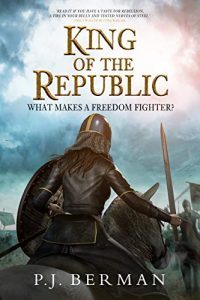 King of the Republic by P.J. Berman:
King of the Republic by P.J. Berman:
Queen Silrith has fallen. Now she must rise again. However, when her army lands in Etrovansia in search of reinforcements and political support, their welcome is far from warm. Their retreat from one war could start another.
Ezrina, a vengeful Hentani priestess, feels the weight of expectation placed on her by her tribe. Without Jezna by her side, her headship is a lonely one. Will the arrival of strange new allies prove a welcome help or complicate matters further?
Zethun, an ambitious young politician, rides a wave of public support amid the passion of revolution. Now he must restore order before the mob descends into anarchy.
All three rebels stand on the precipice of their defining moments. There is no going back now.
Meanwhile, the tyrannical usurper, King Jostan, brings new violence to the Verusantian reign of terror over Bennvika.
 Planet Killer by Lindsay Buroker:
Planet Killer by Lindsay Buroker:
Casmir has survived against impossible odds, and now he longs to return home. But an invasion force is blockading the Kingdom’s wormhole gate, and it would be suicidal to fly through it now. Worse, his family and friends are stuck on the other side, with hostile forces attacking their home world.The only way Casmir can help is to find out who’s behind the invasion… and convince him to stop. But Casmir isn’t known for his ability to strong-arm people, and this is one enemy who won’t be won over by his friendly demeanor. As he soon finds out, he must face the very rich and very powerful person who’s been trying to have him killed for months.
 Firebird’s Lair by Rachel Ford:
Firebird’s Lair by Rachel Ford:
A mysterious warlock. A ruthless band of wyvern poachers. A marriage neither of them wants.
Tsar Kirill’s only daughter is ailing. Poachers and robbers plague his kingdom. He doesn’t want a wife. Especially not that one.
Tsarevna Yuliana has a home already. She doesn’t want to leave everything she’s known, the seaside that she grew up by, to start a new life in a strange land. Especially not with him.
But Tsar Fyodor, his ally and her father, has other plans. He wants to forge an empire. And empire building by marriage is so much less taxing than empire building by war.
Or so he thinks.
First at odds, Yuliana and Kirill unite to outwit Fyodor and save themselves from his machinations. But as a mysterious sorcerer and a dangerous band of wyvern poachers threaten the future of both kingdoms, the two must risk everything – including their hearts – to save the hard-won peace.
A humorous fantasy novel, full of lovable characters, dangerous villains, and laugh-out-loud moments.
He betrayed her. Her revenge will shake their worlds.
Captain John Lang has devoted his life to his duty. Raised as a child soldier, he has never known another life.
And since the cold war between Earth and Mars has been going on for over two centuries, he never will.
To save his lover, Raina, from the same fate, he sent her to Earth.
But things didn’t go for Raina the way John expected them to. Wearing an artificial face, she works as a corporate assassin for the Earth’s largest weapons manufacturing syndicate.
On Earth, she’s an escaped prisoner while on Mars, she’s officially dead. And has neither forgiven nor forgotten.
So, when Earth bans deep core mining, creating a system-wide osmium shortage, she seizes the opportunity and escalates the crisis.
For if she manages to make Earth and Mars go to war, they are sure to destroy each other. And her syndicate would then rule over the wasteland.
After all, she could have no better revenge than for John and all his soldier brothers to die in a nuclear apocalypse.
Superheroes are big business. Imagine not being able to afford them.
Kit Baldwin just wants to make rent. The only work she can find in the ruins of her devastated city is scavenging for alien technology. When she finds a powerful alien weapon, her discovery pays off more than she could have hoped: it draws the attention of the most powerful of the superhuman Empowered, Valene.
Valene hears everything, everywhere. She suffers for it, and as they begin a precipitous romance, Kit believes she can use the weapon she’s scavenged to mitigate Valene’s pain. If she can’t, Valene will retreat to the soundlessness of space. Without Valene’s compassion, the stricken city is left to the mercy of Valene’s ruthless father, who denies the assistance the city needs unless it can pay for it.
As Valene’s condition worsens, Kit becomes more desperate and unleashes the full power of the alien weapon. In an instant, she is transformed into a being of cosmic power. She can acquire the knowledge and energy of anything – or anyone – she touches.
 Ghostly Charms by Lilly Harper Hart:
Ghostly Charms by Lilly Harper Hart:
Harper Harlow thought the only thing she was going to have to worry about in the shadow of spring was planning her wedding. She was wrong.A string of break-ins in Whisper Cove have caught the attention of the cops, including her fiancé Jared Monroe. Things take a turn for the worse when one of those break-ins results in the death of a local barber. It seems what was once written off as teenage hijinks is something else entirely. In addition to the break-ins, Harper finds herself distracted by a new resident. He’s bringing an art gallery to town … as well as his troubled sister. Rain Porter doesn’t want to be in Southeastern Michigan and she’s hiding a big secret. Harper is determined to help the girl until the young woman pushes the exact wrong buttons. Things aren’t what they seem and the deeper Harper digs the more she worries that she doesn’t really want to find an answer. When a ghost from the other side of the state shows up and starts invading her dreams, things go from bad to worse. Jared wants nothing more than to protect Harper, but there are some things he can’t fight … and a ghost is one of them. It’s going to take everyone working together to find a way out of this one and even then survival is not a given. Jump on the ghost train with Harper, Jared, and Zander … because this one is going to be a wild ride.
It is now 2244 and the all-female society of Arkite is on the brink of revolution. Only the return of the Mother Savant can hope to maintain order.
Savant Elise Jackson, Arkite’s supreme leader, is stricken with terrible grief over the recent loss of her lover. She has spent the last two years with her assistant, Sara, trying to repair and genetically engineer her lover’s damaged body and mind.
But the Viceroy of Pyramid City and her followers in the Savant Council have no interest in squandering the city’s resources for Elise’s personal gain. With the help of the mainframe AI, they will vie for power, even attempting collusion with Sara and sabotage.
And even if her enemies fail and Elise somehow manages to revive her lover, Elise knows she’ll have to vie for something she covets even more—her lover’s love. For Sara once loved her just as much, if not more.
Mother Savant is the sequel to Candy Savant—Book 2 in the Candy Savant Series.
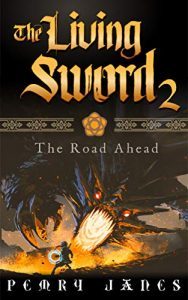 The Living Sword 2: The Road Ahead by Pemry Janes:
The Living Sword 2: The Road Ahead by Pemry Janes:
Eurik & Leraine have escaped the land of the necromancers, but still face a long journey. Eurik is looking for answers about who his parents were and how they ended up adrift at sea. Leraine must carry the news of her teacher’s death back home, yet also has a debt to Eurik for helping her to avenge Irelith.
Together, they’ll have to traverse the Neisham Hills, where lone travelers are snatched in the night and even numbers don’t guarantee safety. And beyond the hills, all along the long Inza Road, the drums of war beat louder and louder.
But the greatest threat may not be goblins, elves, or bandits. It may be the people they’ve chosen to travel with.
Cairo MacKennon doesn’t give a shit about rules, save for one. Avoid SCAR Force at all costs.
When a high-end heist goes south and not even the best stealth ship in the Vedrina trinary system can keep her off SCAR Force’s radar, Cairo’s thieving ways become the least of her problems.
The Space Combat and Retrieval Force doesn’t forget past sins.
And what they have in mind for Cairo’s transgression beats even her worst nightmare.
Scroll up and start reading the first episode in the action-packed sci-fi serial with a slow-burn romance, daring pilots, and space ships galore!
If you can’t have good luck, you should at least have a good dragon.
The princess has inherited the family curse. Plagued by terrible luck, it is all the palace staff can do to keep her safe from herself. When her father pricks himself with an assassin’s needle meant for her, her mother Queen Jade knows there is only one thing they can do. They must seek a cure. To reach it, they will need the help of their greatest protector. But even the great dragon Halfax may not be ready for the challenges ahead.
Halfax is a direct sequel to Jade. It takes place many years after the events of the Book of Deacon series.
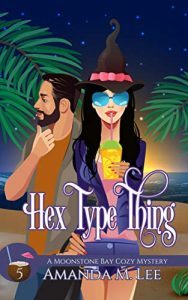 Hex Type Thing by Amanda M. Lee:
Hex Type Thing by Amanda M. Lee:
Hadley Hunter is feeling on top of the world.
She’s embracing her new home on Moonstone Bay and coming into her own as a witch. Her boyfriend Galen Blackwood, who happens to be sheriff, is even involving her in his investigations.
Unfortunately, the peace on Moonstone Bay is about to be threatened.
A local millionaire and a one-hit-wonder songstress are hosting the Skyclad Festival, a paranormal beach extravaganza that features a bevy of famous faces in paranormal circles … and those who want to hobnob with them. There’s only one little problem ….
One of the local influencers, a woman whose only job is to rave about things on the internet, ends up dead. Then, in short order, the organizer himself goes missing. That means Galen is on the case … and Hadley insists on serving as his sidekick.
There are a lot of witches on the island. The question is: Is magic to blame for murder or is something more insidious happening?
It’s going to take everyone working together to find the correct answers – and keep each other safe – as the problem on the beach deteriorates.
Someone has murder on the mind and Hadley is determined to find the culprit. All she has to do is survive long enough to uncover a mystery that has roots in a past long since forgotten … well, and not step on the wrong witchy toes.
The odds of doing both seem long but where there’s a witch, there’s a way.
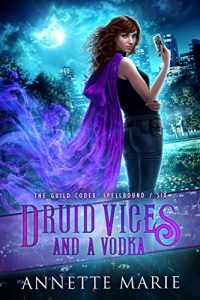 Druid Vices and a Vodka by Annette Marie:
Druid Vices and a Vodka by Annette Marie:
I’ve said it before, but sometimes I’m a bad person. I cheated on my twelfth grade math final, I’ve run countless yellow lights, and I gossip about how hot my kickass best friends are. (Good thing my job as a guild bartender doesn’t require moral perfection.)
But there’s bad, and then there’s bad. And I’m not sure which applies to a certain dark druid/wanted criminal/reluctant friend of mine. His transgressions include black-magic dealings, kidnapping, and murder, and he’s about to add “revenge-fueled killing spree” to his resume—if I don’t stop him.
Should I stop him?
He and his nemesis are gearing up to tear each other apart, rogues and vultures are converging with their sights on the spoils, and the guilds that would normally stomp them into the ground are under attack. We’re on the verge of an all-out criminal turf war, and my time to decide is almost up.
Who’s the real bad guy … and do I dare stand in his way?
 Sky Scorcher by Harlan J. Meade:
Sky Scorcher by Harlan J. Meade:
James Blackwin and his body guard, Misty, are appointed to provide security for the King’s Ball, but their plans are soon disrupted after Misty has a dangerous encounter with a mysterious man with ill intentions. Join James and his crew on board his flying airship as he attempts to defeat pirates, recover stolen plans, and save his friend. Will he prevail or will the obstacles he must face be more than he can handle?
Half human, half angel, 100% pissed off.
Mason Albrecht’s life changed the day the angels tried to kill him. As the son of a fallen angel king, Mason is an abomination, one who can command the Vestments, divine arms and armor summoned from heaven’s own arsenals. And everybody wants a piece: death witches, demon princes, even deities of ancient myth.
Then an enterprising enchantress offers to cloak Mason from those who would corrupt him into a living weapon. But will Mason run from supernatural entities forever, or embrace his unholy birthright and defy the very forces of heaven and hell?
Sins of the Father is a new adventure series from Nazri Noor, bestselling urban fantasy author of the Darkling Mage series. Follow Mason’s first steps in Fallen Reign, a humorous, high-impact supernatural suspense story filled with magic, mythology, and plenty of mayhem.
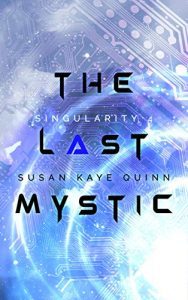 The Last Mystic by Susan Kaye Quinn:
The Last Mystic by Susan Kaye Quinn:
What if you knew there was life after death?
Eli is back from the dead… and determined to stop the powerful ascenders who blasted him out to the void. But in the three days he was gone, the world moved on. The girl he loves is determined to build an army of augmented humans to fight the ascenders—with herself as the next Offering. The ascenders are lining up in a death cult based on the charismatic ascender Eli accidentally released from storage—and all the restraints that have kept the ascender world in balance are now off. Everyone is rushing to be the first to bring a Second Singularity—to reach the numinous world from which Eli just returned—regardless of the cost. And the chaos and bloodshed of the first Singularity show just how high that cost can be. How can he stop the world from hurtling off the cliff when he’s the one who proved there’s something to reach, if only you could learn how to fly?
The Last Mystic is the thrilling conclusion to the Singularity series. This philosophical, HopePunk sci-fi series explores the intersection of mind, body, and soul in a post-Singularity
 Price of Imerpium by Dave Robinson:
Price of Imerpium by Dave Robinson:
The Imperium is on the brink of annihilation, and only one person can save it.
After centuries of peace, the Enemy has returned, and the only one who can unlock the Imperium’s last line of defense is the rightful emperor. Unfortunately, the throne has been empty for a decade.
The sole remaining heir is rumored to be on a backwater planet where no one has heard of the Imperium. Can he be found before the Imperial system is dissolved and the ships of the Imperial Guard are sent to the Wreckers?
Tam’s a destroyer skipper who’s been passed over for promotion one too many times. He’s on a routine mission in his last command.
Meanwhile, on Earth, a homeless man dreams of the stars. John doesn’t know who he is, or where he’s from. He just knows someone will come looking for him and he needs to be found.
Jayne is a woman who works at a homeless shelter in Seattle and finds herself a long way from home.
Who among them will be willing to pay the Price of Imperium?
Two people fleeing their planets discover a shared destiny.
When an alien spacecraft crashes on Mars, the repercussions sweep throughout the solar system and endanger the fragile new alliance with the Warrish mermen.
Alarik Kenton Tallis, Eldest of three brothers, was forced to infiltrate human society on Earth as a spy to insure his injured brother receives proper medical care. But, when his transmissions are detected, he must flee the planet.
On Mars, Phoebe Wong, a veterinary scientist with dubious family connections, is desperate to escape the underworld gangs terrorizing the domed city. She jumps at the chance to join the colonists bound for a distant exoplanet.
Their paths converge on a space ferry bound for the outer planets. Troubles created by the mysterious spacecraft pursue them to Jupiter. Will their flight end on Europa, the hyperspace gateway to the stars protected by three diverse species?
 Shifters and Sabotage by Lily Webb:
Shifters and Sabotage by Lily Webb:
All’s fair in love and roar…
Zoe Clarke’s life is changing shape. After solving a litter of paranormal mysteries, Zoe’s ready to slow down and focus on domestics with her new live-in shifter boyfriend, Beau.
But someone in Moon Grove is eaten up with jealousy about their relationship — as Zoe learns from the series of disturbing anonymous letters addressed to Beau in their mailbox. So when Zoe finds Beau trapped in his golden retriever form, it’s up to her to sniff out what happened.
From his obsessive co-workers to the secretive community of shifters surrounding him, Zoe’s convinced the attacker is someone in Beau’s pack — until another prominent shifter is found locked in their animal form.
Can Zoe track down the culprit and reverse the shifter curse? Or will the attacker take a bite out of her too?
Shifters and Sabotage is the seventh book in the Magic and Mystery series of witch cozy mysteries. If you like shady shifters, raving reporters, and magical murder mysteries, then you’ll love this lighthearted seventh entry in Lily Webb’s spellbinding series.
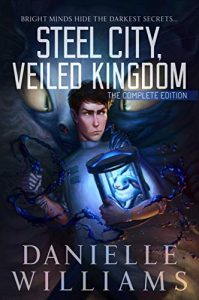 Steel City, Veiled Kingdom: The Complete Edition by Danielle Williams:
Steel City, Veiled Kingdom: The Complete Edition by Danielle Williams:
Jerimin Icarii’s life is in shambles. Once an ambitious young scientist, years of hardship on the streets of his homeworld have transformed him into a desperate man, willing to do anything to get his life back.
In his darkest hour, he strikes a deal with the bizarre Queen of the faerie world. Now her supernatural powers help him keep up appearances while he claws his way back into society. The longer he keeps up the charade, the closer he gets to respect, wealth, and glory. But one slipup will get him killed.
And that’s not even the dangerous part. Because the cost of the Queen’s aid is obedience to her every whim. And Jerimin never knows what she’ll make him do next…
Steel City, Veiled Kingdom is a science fantasy overflowing with intrigue, adventure, and colorful characters you’ll love (and a few you’ll love to hate). It’s the perfect story for any sci-fi/fantasy lover looking for an immersive, inventive read.
Steel City, Veiled Kingdom: The Complete Edition presents the entire story as it was originally envisioned–as a single, complete, epic-length novel. The Complete Edition is only available in digital format at this time. However, all 5 parts of the story are offered as individual volumes in both digital and paperback and are listed here:
 Send to Kindle
Send to Kindle
January 29, 2020
Indie Crime Fiction of the Month for January 2020
 Welcome to the latest edition of “Indie Crime Fiction of the Month”.
Welcome to the latest edition of “Indie Crime Fiction of the Month”.
So what is “Indie Crime Fiction of the Month”? It’s a round-up of speculative fiction by indie authors newly published this month, though some December books I missed the last time around snuck in as well. The books are arranged in alphabetical order by author. So far, most links only go to Amazon.com, though I may add other retailers for future editions.
Our new releases cover the broad spectrum of crime fiction. We have cozy mysteries, small town mysteries, animal mysteries, hardboiled mysteries, historical mysteries, medieval mysteries, Victorian mysteries, Jazz Age mystries, paranormal mysteries, crime thrillers, legal thrillers, spy thriller, historical thrillers, pulp thrillers, police procedurals, romantic suspense, private investigators, amateur sleuths, judges, FBI agents, police officers, Pinkerton agents, spies, ex-cons, serial killers, kidnappers, missing children, heists, con artists, organised crime, crime-busting witches, crime-busting writers, crime-busting cats, crime-busting ghosts, pinched Pisarros, crime and murder in New York City, Denver, East Berlin, Scotland, Snowdonia, Miami and much more.
Don’t forget that Indie Crime Fiction of the Month is also crossposted to the Indie Crime Scene, a group blog which features new release spotlights, guest posts, interviews and link round-ups regarding all things crime fiction several times per week.
As always, I know the authors at least vaguely, but I haven’t read all of the books, so Caveat emptor.
And now on to the books without further ado:
 Where Missing Boys Go by Parker Avrile:
Where Missing Boys Go by Parker Avrile:
A missing ex. Two missing children. And the man caught in the middle of a cartel’s proposed hostage exchange.
When his boyfriend vanished with stolen millions, Darke went to prison for his part in the heist. Another man might want revenge. All he wants is the chance to rebuild his life with a new and better man, former FBI Special Agent Flare Greene.
But everybody else– including the FBI– still wants the millions.
When a faceless organization grabs two small hostages to force Darke to lead them to the missing money, he no longer has a choice. He must find his elusive ex or die trying.
And death is not an option as long as the two boys are in the hands of kidnappers.
Meanwhile, the FBI is dangling a mysterious new assignment in front of Flare? an assignment very far away from the rescue of two small hostages. What are the higher-ups in the bureau up to?
If they think they’re going to stop Darke Davis from finding the money first and saving those boys, they’ve got the wrong guy.
Nobody and nothing is stopping Darke from saving those boys.
Not his devious ex.
Not the FBI.
Not even Flare.
Hunting a serial killer can be hazardous to your health.
My name’s Selena Valeron, and I’m the Supernatural Bureau of Investigation’s best undercover witch. After three years, the bureau has just handed me my biggest case: hunting the magical community’s most prolific serial killer, Xavier.
Lately the dead women on the morgue table bear an eerie resemblance to me. A shocking revelation indicates the killer is someone from my past—if I can remember it. Years ago, an accident wiped out my memory and threatened to end my career. Now my magical powers seem to be manifesting into something stronger.
Was my memory loss really an accident, or a failed murder attempt?
Time’s ticking as I dig through my past to find the killer. I need answers. If I can’t get them in time, I’ll lose friends, family—even my own life.
MAGIC LIES is a fast-paced urban fantasy mystery with plenty of thrilling twists and turns that will keep you guessing. Agent Valeron may have lost her memory, but she hasn’t lost her snarky attitude and she’s still a badass witch. Jump into this magical world and start reading the Selena Valeron series today!
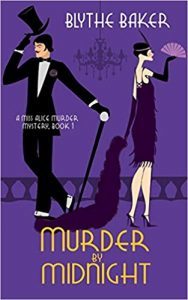 Murder by Midnight by Blythe Baker:
Murder by Midnight by Blythe Baker:
Murder and mystery in a Scottish castle…
When Alice Beckingham boards a train for Edinburgh in 1929, she begins a journey that will test everything she thinks she knows about her past and her family. From the moment of her arrival at the rugged and remote Druiminn Castle, something sinister haunts her steps.
With the murder of her host and the revelation that one of her fellow guests at the castle is an unscrupulous jewel thief, Alice resolves to uncover secrets that someone will stop at nothing to keep hidden.
Coercing the coolly unpredictable Sherborne Sharp into assisting her, Alice follows in the footsteps of her detective cousin Rose and pursues a heartless killer through glittering dining rooms, shadowed passages, and moonlit groves. A mysterious local legend may hold the key to unraveling everything, but will Alice survive long enough to decipher it?
 The Pinched Pisarro by Will Briggs:
The Pinched Pisarro by Will Briggs:
Sam Powell is a down on his luck con-man on the run from a vindictive ex-con whom he has double crossed.
His luck turns when he’s given one last shot at working for a criminal organization led by an enterprising Park Avenue butler. His mission: steal an invaluable Pissarro from one of Manhattan’s richest socialites.
However, Sam’s ex-partner (who happens to be his ex-girlfriend) doesn’t want anything to do with him so he’s forced to recruit his unwitting neighbor, a struggling piano tutor named Wendell Hoyt, to help.
Sam and Wendell find themselves pitted against a psychopathic hit-man, a criminal organization, and Wendell’s authoritative aunt.
Together they could end up millionaires…if they survive.
 The Heavy Hand of the Editor by Cora Buhlert:
The Heavy Hand of the Editor by Cora Buhlert:
New York City, 1938: Richard Blakemore, hardworking pulp writer by day and the masked vigilante only known as the Silencer by night, has faced many a horror in his day. But few of them can match the terror of the blank page. Especially since Donald A. Stuart, the upstart young editor of an upstart young magazine called Stunning Science Stories, has already rejected Richard’s story “The Icy Cold of Space” four times.
Stuart demands changes that Richard does not want to make. Worse, he also holds Richard’s story hostage. Unless Stuart permanently rejects the story, Richard cannot sell it elsewhere.
There are a lot of shady practices in the pulp business, but Stuart’s actions are beyond the pale even for the wild west of publishing. And so the Silencer decides to pay Stuart a visit to put the fear of God into an editor who believes himself to be one.
This is a novelettes of 10800 words or approx. 38 print pages in the Silencer series, but may be read as a standalone.
Any resemblances to editors, writers and magazines living, dead or undead are entirely not coincidental.
 Hijinks and Murder by Beth Byers:
Hijinks and Murder by Beth Byers:
January 1926
Violet has received an obscure note, a strange request, and the claim of a murder. She’d like to ignore it, but the writer knows too much about her.
Has someone died? Who is the author of the note and why are they dragging Violet into this crime? Just what is going on and will Violet be able to reach the bottom of this madness?
A desperate agent. A petty criminal. An audacious plot.
When Harry Mackintosh is called upon to exfiltrate a valuable asset from East to West Berlin, what could have been an intelligence coup becomes an international embarrassment. Mackintosh’s men and his lover are killed by the East German secret police in a brutal crossfire and he barely escapes with his life. He flees to the West and promises himself that he will have vengeance.
Mackintosh is the head of Berlin Station but he doesn’t have the staff to compete with the Stasi. He returns to London to plead for the resources to fight back. But instead of the seasoned operatives that he needs, Mackintosh is given a single man: Jimmy Walker, a petty criminal with a record for robbing banks.
Mackintosh takes Walker to Berlin and sets in train an audacious plan that will see them both on the other side of the Wall. Mackintosh and Walker face off against Karl-Heinz Sommer, the Stasi general known as die Spinne – the Spider – a man known for his brutality and ruthlessness.
The plan is already a longshot, and then Walker learns of the riches that Sommer stole from displaced Berliners in the days after the Wall was constructed. Will Walker follow orders or will he find the prospect of the Stasi gold in Sommer’s secret vault too tempting to ignore? Will Mackintosh have his revenge or will he become another fly caught in the Spider’s web?
With ambiguous loyalties, clashing agendas and danger beyond measure, these two men will struggle to form a team. But in a battle as unequal as this, the unexpected might be the best strategy that they have.
 Ghostly Charms by Lilly Harper Hart:
Ghostly Charms by Lilly Harper Hart:
Harper Harlow thought the only thing she was going to have to worry about in the shadow of spring was planning her wedding. She was wrong.A string of break-ins in Whisper Cove have caught the attention of the cops, including her fiancé Jared Monroe. Things take a turn for the worse when one of those break-ins results in the death of a local barber. It seems what was once written off as teenage hijinks is something else entirely. In addition to the break-ins, Harper finds herself distracted by a new resident. He’s bringing an art gallery to town … as well as his troubled sister. Rain Porter doesn’t want to be in Southeastern Michigan and she’s hiding a big secret. Harper is determined to help the girl until the young woman pushes the exact wrong buttons. Things aren’t what they seem and the deeper Harper digs the more she worries that she doesn’t really want to find an answer. When a ghost from the other side of the state shows up and starts invading her dreams, things go from bad to worse. Jared wants nothing more than to protect Harper, but there are some things he can’t fight … and a ghost is one of them. It’s going to take everyone working together to find a way out of this one and even then survival is not a given. Jump on the ghost train with Harper, Jared, and Zander … because this one is going to be a wild ride.
 Die in the Wool by Katherine Hayton:
Die in the Wool by Katherine Hayton:
A sudden death has Tash Mallory all stitched up!
Tash Mallory’s future is in the balance when her employer “Auntie Fran” (no relation) fires her from the knitting shop job she’s held for twenty years. Even worse, when Tash returns to confront her, she finds Fran’s dead body in the back room.
Luckily, the doctor soon concludes the death is from natural causes. A decision cast into doubt when Tash finds out she’s inherited Fran’s store and home.
With an aggrieved nephew determined to fight the will in court and Fran’s despondent fiancé pointing the finger of blame, Tash battles to clear her name. The police mightn’t believe the death was murder, but the good folks of Patiti are quicker to rush to judgement.
If Tash can’t manoeuvre through the undercurrent of small town politics, winning the inheritance will be a Pyrrhic victory. Worse, the doctor’s assessment might be wrong, leaving a killer on the loose.
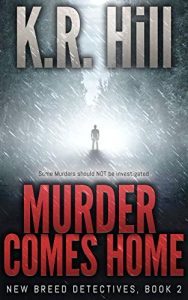 Murder Comes Home by K.R. Hill:
Murder Comes Home by K.R. Hill:
The body was still warm. He’d never forget that touch.
Private investigator Connor Marin butts heads with the Russian mob as he investigates the murder of his best friend.
While working the case, he discovers that his own father, a police detective, had a bloody secret. To get to the bottom of his father’s story, Connor makes enemies of the police department.
With mob thugs threatening from one direction, and angry cops coming at him from the other, Connor is trapped.
How can he protect his beautiful fiancé, learn the truth about his father, and bring down a killer?
 Mooved to Murder by CeeCee James:
Mooved to Murder by CeeCee James:
Chelsea Lawson is a ride-or-die friend. When her best friend Tilly asked her to stay at her place to watch her six-year-old daughter and pets for a while, Chelsea didn’t hesitate to say yes. What she didn’t realize was that “Tilly’s place” was a micro-farm and “a few pets” included a cow and two goats as well as a child who was too smart for her own good.
Chelsea was already in over her head before the dead body turned up.
When the local community, instead of offering support, tries to run her out of town, Chelsea suspects something is going on. Something big and rotten. The mayor makes it clear she’s not wanted and the townspeople give her the cold shoulder, but that only makes Chelsea more determined to uncover their secrets.
But no one expected the repercussions those secrets would have, especially Chelsea. Now life on the farm is hanging in the balance. Will Chelsea ever be able to wake up from this nightmare?
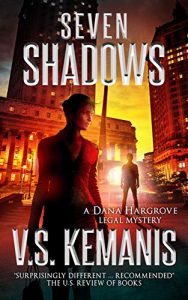 Seven Shadows by V.S. Kemanis:
Seven Shadows by V.S. Kemanis:
A criminal prosecutor is bound to make a few enemies over a decades-long career, and Dana Hargrove is no exception. Who has it in for her?
In 2015, the former prosecutor is in her second year as a trial judge in Manhattan. It’s a new world. Dana cut her baby teeth in the DA’s office during the crack epidemic, the ’80s and early ’90s. Now, the murder rate is a fraction of what it was, and public opinion about incarceration is softening. So is Dana. As a judge, she agonizes over every sentencing decision before her.
Midlife has also hit Dana hard on a personal level. She misses her children and adjusts to the empty nest by immersing herself in work. Instead of growing closer to her husband Evan, their relationship becomes strained. What is happening to them?
Tension builds as Judge Hargrove presides over two high-stakes media cases. The defendants: a glamorous dot-com millionaire who killed her business partner, and an orthopedist who runs a deadly pill mill. In the public mail bag, the judge receives a message from an anonymous crank. Then her family starts getting letters that sound all too personal. Someone with an agenda is harassing and shadowing Dana and her loved ones.
In Seven Shadows, the judge and her pursuer are on a collision course meant to teach Dana the meaning of empathy and the value of the people she cherishes most.
 Hex Type Thing by Amanda M. Lee:
Hex Type Thing by Amanda M. Lee:
Hadley Hunter is feeling on top of the world.
She’s embracing her new home on Moonstone Bay and coming into her own as a witch. Her boyfriend Galen Blackwood, who happens to be sheriff, is even involving her in his investigations.
Unfortunately, the peace on Moonstone Bay is about to be threatened.
A local millionaire and a one-hit-wonder songstress are hosting the Skyclad Festival, a paranormal beach extravaganza that features a bevy of famous faces in paranormal circles … and those who want to hobnob with them. There’s only one little problem ….
One of the local influencers, a woman whose only job is to rave about things on the internet, ends up dead. Then, in short order, the organizer himself goes missing. That means Galen is on the case … and Hadley insists on serving as his sidekick.
There are a lot of witches on the island. The question is: Is magic to blame for murder or is something more insidious happening?
It’s going to take everyone working together to find the correct answers – and keep each other safe – as the problem on the beach deteriorates.
Someone has murder on the mind and Hadley is determined to find the culprit. All she has to do is survive long enough to uncover a mystery that has roots in a past long since forgotten … well, and not step on the wrong witchy toes.
The odds of doing both seem long but where there’s a witch, there’s a way.
 The Snowdonia Killings by Simon McCleave:
The Snowdonia Killings by Simon McCleave:
A small town murder. A big city detective.
DI Ruth Hunter’s dream of escaping the murderous streets of South London and settling in the rural peace of Snowdonia has come true – until a brutal killing turns it into her worst nightmare.
Detective Inspector Ruth Hunter lives with the pain of her partner’s mysterious and unsolved disappearance. About to hit fifty, the veteran police officer trades in the crime-ridden streets of London for a more peaceful life in rural North Wales. But Ruth has barely settled into her new position in North Wales Police, when the body of a brutally murdered woman is discovered…with strange symbols carved into her skin. Teaming up with an obstinate deputy, Ruth struggles to eliminate anyone from a long line of suspects. When another slain victim is discovered with the same cryptic markings, she’s forced to re-think the investigation.
Has Ruth got what it takes to solve the case before the murderer attacks again?
 The Girl That Vanished by A.J. Rivers:
The Girl That Vanished by A.J. Rivers:
Ring…Ring…
One call from her past was all it took to change everything.
A ten-year-old girl has vanished on her way home from camp.
And things took a turn for the worse when another child, a child that Emma knows, goes missing.
Disappearances, death, and tragedies have followed Emma Griffin throughout her childhood.
Her obsession with finding out the truth behind her past was what led her to join the FBI.
It’s been months since the horror of Feather Nest.
After the shocking revelation of the last case, FBI agent Emma Griffin decides to take a much-needed vacation.
But a phone call from Sheriff Sam Johnson, a man from her past, completely derails her plans.
A young girl has disappeared, and another child has gone missing.
With the number count slowly climbing.
Emma must now put her plans on hold, go back to her hometown and face some ghosts from her past.
When a mysterious package appears on her birthday.
Emma can’t shake the feeling that someone is monitoring her every movement.
Someone is getting too close for comfort.
The question is who?
In the close-knit town of Sherwood, the truth is never as it seems.
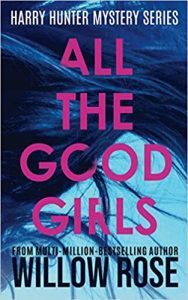 All the Good Girls by Willow Rose:
All the Good Girls by Willow Rose:
Detective Harry Hunter of Miami PD’s homicide squad throws himself into a case no one asked him to solve.
Four teenagers from one of Miami’s affluent neighborhoods are murdered on a boat. Another is found in a dumpster. All five of them go to the same school and are on a list of witnesses to another crime.
Because he’s in bad standing with his boss, Harry is given the task of protecting a possible future victim, but Harry isn’t always known to follow his boss’s orders.
Soon, he’ll risk everything while racing to stop a killer who has left everyone else in the homicide squad shaking in terror.
 An Agent for Pearl by Christine Sterling:
An Agent for Pearl by Christine Sterling:
A quiet woman with no desire to become an agent; an agent with no intention of ever having a partner, and the case that cooks up surprises.
Pearl Bolton has enough on her plate, she doesn’t want to add anything else. She loves her job as a cook for the Pinkerton’s Denver office. At night she rushes home to help take care of her invalid father. The last thing she needs is a husband, no matter how temporary. What she didn’t count on was a case that involved her two passions: baking and Pinkerton Agent Zeke Preston.
Zeke Preston has a crush on the shy cook, and he has the extra ten pounds to prove it! He wishes he could get her to open to him, but Pearl doesn’t appear to need anyone or anything. Every time Zeke comes around, it’s as though Pearl avoids him. He knows exactly what to do to get her attention. Someone has sabotaged a national baking competition and he needs her to help solve the case. The fact he must marry her is just a bonus!
Does Pearl assist Zeke in finding the saboteur? When Pearl is the victim of a crime, will Zeke be able to protect her and solve the case? Will their marriage end at the case’s conclusion, or will they bake up something new together?
One of medieval Ludlow’s mills burns to the ground during a cold November night. Former coroner Stephen Attebrook walks down to the site out of curiosity the following morning like many of the town’s residents, where he discovers the charred corpse of the miller in the smoldering ruins. It could have been an accident, but the evidence points to murder. Mysterious deaths are no longer Attebrook’s business — or so he mistakenly supposes. The constable of Ludlow Castle, anxious to ingratiate himself with the local lord who owns the mill, pushes Attebrook into pursuing the culprit, a move that pitches him into a tapestry of murder and robbery that reaches even into his own home — for a rampaging criminal gang steals all the money he has in the world, threatening him with poverty and ruin. Pulled two ways, Attebrook must decide whether to save his fortune or seek justice for the miller’s death.
 Shifters and Sabotage by Lily Webb:
Shifters and Sabotage by Lily Webb:
All’s fair in love and roar…
Zoe Clarke’s life is changing shape. After solving a litter of paranormal mysteries, Zoe’s ready to slow down and focus on domestics with her new live-in shifter boyfriend, Beau.
But someone in Moon Grove is eaten up with jealousy about their relationship — as Zoe learns from the series of disturbing anonymous letters addressed to Beau in their mailbox. So when Zoe finds Beau trapped in his golden retriever form, it’s up to her to sniff out what happened.
From his obsessive co-workers to the secretive community of shifters surrounding him, Zoe’s convinced the attacker is someone in Beau’s pack — until another prominent shifter is found locked in their animal form.
Can Zoe track down the culprit and reverse the shifter curse? Or will the attacker take a bite out of her too?
Shifters and Sabotage is the seventh book in the Magic and Mystery series of witch cozy mysteries. If you like shady shifters, raving reporters, and magical murder mysteries, then you’ll love this lighthearted seventh entry in Lily Webb’s spellbinding series.
 Send to Kindle
Send to Kindle
January 26, 2020
Retro Review: “The Jewel of Bas” by Leigh Brackett
[image error]“The Jewel of Bas” by Leigh Brackett is a science fiction novella, which appeared in the spring 1944 issue of Planet Stories and is therefore eligible for the 1945 Retro Hugos. The magazine version may be found here. This review will also be crossposted to Retro Science Fiction Reviews.
Warning: There will be spoilers in the following!
The protagonists of “The Jewel of Bas” are two newlyweds, Ciaran (a name Brackett would reuse for the 1951 Eric John Stark story “Black Amazon of Mars”) and Mouse. Ciaran and Mouse are drifters. Ciaran is a wandering balladeer who carries a harp and sings songs about the old legends of his planet, while Mouse is primarily a pickpocket and petty thief. Both these skills will serve them well in the adventure to come. Ciaran and Mouse call themselves gypsies, a term which is considered offensive now, but was still in common use in 1944. Ciaran and Mouse are not even the only self-proclaimed Romani in Leigh Brackett’s planetary romances of the 1940s. “The Citadel of Lost Ships”, a finalist for the 1944 Retro Hugo, features an entire space station full of intergalactic drifters who refer to themselves by the g-word. Uncommon for the time, Leigh Brackett has a lot of sympathy for her Romani protagonists.
Unlike Isaac Asimov, Leigh Brackett does give us pretty detailed descriptions of her characters. And so we learn that both Ciaran and Mouse are fairly short and skinny, probably due to not always having had sufficient food, and Ciaran has bent legs, too. Ciaran has a scar on his lip and is missing a tooth, Mouse has curly dark hair and a brand between her eyes that marks her as a thief. Both Ciaran and Mouse have brown skin, so here we have a golden age story with two unambiguous protagonists of colour.
Ciaran and Mouse are more typical characters for a Leigh Brackett story than Lundy from “Terror Out of Space”. For most of Brackett’s protagonists are outsiders who live on the margins of their respective societies. Many are thieves or criminals of sorts and quite a few are people of colour, including what is probably Leigh Brackett’s most famous character, Eric John Stark. But unlike Eric John Stark and other Brackett protagonists, Ciaran and Mouse are not physically impressive. And though we are never given their age, but Ciaran and Mouse feel young, late teens or early twenties. Younger than most other Brackett protagonists, at any rate. Their relationship is volatile and they quarrel a lot, occasionally escalating into violence, even though they clearly love each other.
In fact, the story starts with Ciaran and Mouse quarrelling, as they are having dinner on a ledge overlooking an area called the Forbidden Plains. Mouse is scared, because she has never been outside the city before. And besides, there are rumours about people going missing near the Forbidden Plains. But Ciaran assures her that the shortcut they took is perfectly safe, even if it passes by the Forbidden Plains. While he’s at it, Ciaran also gives us a handy introduction to the old legends of his world, which he uses as fodder for his ballads, such as the story of Bas the Immortal who lives inside Ben Beatha, the Mountain of Life which overlooks the Forbidden Plains, with his android servants and a non-human slave race called the Kald. Bas the Immortal owns the Stone of Destiny, a powerful jewel that allows him to rule the world. Ciaran assures Mouse that those are just legends, stories to frighten children with, though he also dreams of climbing Ben Beatha and getting his hands on the jewel one day. He will get his wish.
Mouse and Ciaran’s dinner is interrupted by a shadow falling onto the ledge where they’re resting. They are frightened, for their world knows no night. By now, we are wondering just where exactly “The Jewel of Bas” is set. Leigh Brackett normally set her planetary romances in pre-spaceflight consensus version of our solar system that never was with Mars and Venus being particularly popular settings. However, the world of “The Jewel of Bas” with its sun balls and permanent daylight doesn’t match Brackett’s version of Mars or Venus or Mercury or indeed any other planet of the solar system. So did Leigh Brackett actually write a story set on an extrasolar world, thirty years before the Skaith trilogy? Or is something else going on here? It’s a mystery that will be resolved by the end of the story.
Soon after the incident with the shadow, Ciaran and Mouse find themselves in even worse trouble, when they are attacked and kidnapped by vaguely humanoid creatures with grey skin and pink eyes. Before he is knocked out, Ciaran recognises their attackers as Kalds, the non-human servants of Bas the Immortal. So if that part of the legend is true, maybe the rest is true as well?
When Ciaran comes to again, he and Mouse find themselves chained together with other people abducted by the Kalds and herded across the Forbidden Plains towards Ben Beatha. However, Mouse’s unconventional upbringing has also given her some mean lockpicking skills, which she uses to free herself, Ciaran and several other prisoners from their chains. The prisoners revolt and attack the Kalds, when another shadow falls onto a world that doesn’t know darkness. Ciaran and Mouse manage to escape in the ensuing chaos. The join forces with some of their fellow escapees, a big red-haired, nearly naked hunter, a wild-eyed hermit who appears to be insane and a dark-skinned trapper named Ram, whose wife and son were also abducted by the Kalds.
Because the Kalds have closed off all other escape routes, Ciaran, Mouse and their comrades have no choice but to head further towards Ben Beatha. Ram is killed in a fight with the Kalds, though not before finding his wife and son dead by the wayside. Meanwhile, Ciaran, Mouse, the hunter and the hermit sneak into a cave at the foot of Ben Beatha and find themselves staring into a pit, wherein a huge machine is being built. The human prisoners are used as slave labour to build the machine. They also seem to be drugged or hypnotised, not caring whether they live or die. And in fact, several slaves drop dead from exhaustion right in front of the eyes of Ciaran and his companions.
Ciaran and friends make it to the bottom of the pit undetected. Here, Ciaran finds proof that yet more of the old legends he used to sing about are true, for they witness one of the androids of Bas the Immortal hypnotising the new prisoners via some kind of mesmerising light. Mouse and the hermit are also affected by the light – only Ciaran and the hunter manage to escape, though not before overhearing that the androids are worried about something failing and that the machine will not be finished in time. They also overhear that the androids are planning to overthrow Bas the Immortal and rule the world themselves.
During their escape, Ciaran and the hunter are separated. Ciaran knows that the slaves are being worked to death and that things will only get worse with the androids in charge. Desperate to save Mouse from that fate, he decides to climb Ben Beatha to find Bas the Immortal and enlist his help against the androids. While he is climbing, Ciaran also notes that the sunballs which provide his world with light and warmth are dimmer than they used to be.
Ciaran eventually reaches an outcropping near the top of the mountain, which turns out to be a balcony leading to the quarters of Bas. He ventures inside and gets the surprise of his life, when he finally finds Bas, asleep on a bed which is shaped like an ankh, the Egyptian symbol of life (though Brackett uses the Latin term “crux ansata” for the symbol). For Bas is not the ancient and godlike immortal Ciaran has envisioned. Instead, he is a teenaged boy, perpetually young due to his immortality. At this point, Ciaran also remembers another legend, older than most, about the Shining Youth from Beyond, a boy who never grows old. So that legend is true as well.
Ciaran tries to wake Bas, only to be thwarted by the curtain of light that surrounds Bas and his ankh-shaped bed. When the curtain of light flickers out due to a convenient power failure (The frequent power failures in the story are timed very conveniently, even though there is an in-story reason for them), Ciaran still cannot get Bas to wake up. Desperate, Ciaran finally sits down on Bas’ bed and begins to play sad songs on his harp, which does the trick. Bas is awake at last, though not exactly happy about it.
We now get a brief rundown of the long history of Bas the Immortal. Bas, we learn, was a fisherman’s son from Atlantis. He gained his immortality as well as the Stone of Destiny from a meteor strike. Now Bas had eternal life and the powers of a god, but because of his youth he was never respected, only hated. Eventually, he left Earth with his androids and the Stone of Destiny and settled on the tenth planet of the solar system. Inside the hollow tenth planet, Bas built a world of his own, lit by sunballs and powered by the Stone of Destiny, and populated it with humans imported from Earth as well as the alien Kalds. But the people of this world also quickly came to hate Bas and so he went to sleep to live in his own dream world and left the androids in charge of the world he had created.
This conversation occurs in the penultimate chapter of the novella and finally clarifies where exactly the story is set, namely on or rather inside a hypothetical tenth planet of our solar system (Pluto was still considered the ninth planet back then). In fact, I wonder why Leigh Brackett didn’t simply use Pluto instead, especially since hardly anything was known about Pluto a mere fourteen years after its discovery. But then, hypothetical trans-Neptunian planets are very common in science fiction well into the twenty-first century, almost as common as real trans-Neptunian objects.
But though the revelation of where exactly the story is set only happens towards the end, Brackett weaves in hints regarding the nature of this world throughout the story such as the sunballs or the fact that neither Ciaran nor Mouse have ever experienced darkness before and are terrified by it as well as a moment early on where Ciaran recalls one of the legends surrounding Bas the Immortal, according to which Bas was born on a world with only one big sunball, where the sky changes from light to dark “like a woman’s fancy” and where the horizon curves down. So yes, the clues to the nature of this world are there from the beginning, even though I completely managed to miss them upon first reading.
The world of Ciaran, Mouse and Bas is also highly reminiscent of Edgar Rice Burroughs’ Pellucidar (which is eligible for the 1945 Best Series Retro Hugo), for Pellucidar also has a horizon that curves upwards, is also lit by a sunball and also knows no night. And considering Leigh Brackett has stated that she was a fan of Edgar Rice Burroughs and that Burroughs’ Tarzan was a big influence on Eric John Stark, it’s very likely that she read the Pellucidar novels. However, Burroughs places his Pellucidar “At the Earth’s Core”, whereas Brackett places her world on a planet beyond Neptune. It’s certainly a fascinating world and I wonder why Leigh Brackett never revisited it in future stories like she kept revisiting her versions of Mars and Venus.
However, Ciaran and Bas don’t have much time to dwell on the exact nature of their world. For the Stone of Destiny, which powers the sunballs and keeps the world habitable, is failing. Once it does fail, everybody in this world except for Bas and his androids will die. And life won’t exactly be pleasant for Bas and the androids either, considering they will be trapped on a frozen rock in space. Ciaran also deduces that this is why the androids are using the human slaves to build the gigantic machine he saw earlier, as a replacement power source for the failing Stone of Destiny.
Ciaran has the hardest time convincing Bas, the solar system’s oldest emo teenager, to help, since the fatalistic Bas declares that thousands of people dying is no big deal, since human lifespans are so short anyway. And besides, he’d much rather sleep. It’s only when Bas realises that the androids plan to do away with him as well that he agrees to help.
Together, Bas and Ciaran set out to confront the androids, just as the machine the slaves built starts up. The androids try to hold Ciaran and Bas back by siccing the Kalds on them. But the Kalds succumb to Bas’ telepathy, so the androids have the hypnotised human slaves block the way. Bas cannot see a way past the slaves without hurting or killing anybody. So Ciaran draws the human slaves away with his harp, pied piper style, while Bas turns the last bits of power in the Stone of Destiny against the androids, destroying them. The slaves are freed and the world is saved.
Ciaran and Mouse try to persuade Bas to stay with the people he saved, but Bas won’t hear anything about that. Sooner or later, in a couple of generations, they’ll only hate him again, he says fatalistically and goes back to sleep to live in his dream world with his perfect dream girl. Ciaran and Mouse bid him good-bye and realise that even if their lives are limited, they are much happier than Bas the Immortal will ever be.
[image error]“The Jewel of Bas” is a glorious pulpy adventure story that manages to offer up plenty of twists and turns, whether it’s the revelation where the story is set or Bas the legendary Immortal turning out to be a sullen emo teenager whose initial response to the impending end of his world is a shrug and “Whatever”. Bas only appears in the final three chapters of the novella, but he is certainly a memorable character, both a tragic figure and an annoying brat.
Dying worlds, mysterious relics and ancient legends that turn out to contain considerably more than a kernel of truth are common themes in Leigh Brackett’s work and “The Jewel of Bas” has all of them in spades. Leigh Brackett’s stories often inhabit the borderland between science fiction and fantasy. “The Jewel of Bas” tilts further towards fantasy than most. Yes, the story is set on another planet, there is a mysterious machine and there are androids, but Leigh Brackett isn’t particularly concerned about how any of this works. If this novella had been published in Astounding, we would have been treated to pages of technobabble about how the machine powering the planet works and how the androids were built. Leigh Brackett, however, isn’t interested in the details of her wholly imaginary technology. We get a few lines that the machine is powered by the rotation of the planet and by vibration, before we get back to the adventure and the crisis at hand. And the androids are no Asimovian robots with positronic brains and careful programming, they’re just a monster to fight and an obstacle to be overcome. Indeed, the story would have worked just as well, if Leigh Brackett had simply waved her hand and said “magic”, when asked how exactly the imaginary technology works. And indeed, the Stone of Destiny is pretty much magic. “The Jewel of Bas” is wallpaper science fiction, but it is also an excellent example why wallpaper science fiction often endures long after harder science fiction has become hopelessly dated.
Leigh Brackett’s planetary romances are exactly what the term “sword and planet” as an analogue to sword and sorcery was invented to describe. In fact, Adventures Fantastic notes in their review of “The Jewel of Bas” that the story not only feels like a sword and sorcery tale, but that it also pays homage to several popular sword and sorcery works. And so Ciaran plays a tune played at the funerals of Cimmerian chieftains at one point and mentions an ancient legend from the forests of Hyperborea at another, paying homage to both Robert E. Howard’s Conan (who hails from Cimmeria and visits Hyperborea) and Clark Ashton Smith’s Hyperborean Cycle. And we know that Leigh Brackett was a fan of Robert E. Howard’s work and even named a character in “Lorelei of the Red Mist”, her 1946 collaboration with Ray Bradbury, Conan after Howard’s barbarian, a decision she later regretted when the Conan stories were reprinted to huge success in the 1960s and the name became forever associated with the Cimmerian barbarian.
Adventures Fantastic also points out that the red-headed hunter who aids Ciaran and Mouse during their escape is reminiscent of Fritz Leiber’s red-headed barbarian Fafhrd. In this case, the link is more tenuous than in the previous example, but the interactions between Ciaran and the hunter are a little reminiscent of Fafhrd and the Gray Mouser down to the hunter calling Ciaran “little man”, which is how Fafhrd often refers to the Mouser. Though Fafhrd is the bard in that legendary partnership. Furthermore, it’s also notable that there is a character, albeit a female one, called Mouse in “The Jewel of Bas”, considering that Mouse was the Gray Mouser’s original name, before he decided to rebrand himself. Though this little tidbit would not be revealed until the novelette “The Unholy Grail” in 1962, i.e. eighteen years after “The Jewel of Bas”. Though it is pretty obvious that the various SFF authors of the golden age were all reading each other’s work, even if they didn’t know each other personally, and so occasionally dropped little Easter eggs into their stories.
[image error]
I first encountered the story in this Gollancz Fantasy Masterworks collection.
The stereotypical protagonist of golden age science fiction is the competent man (and it is almost always a man, the occasional Susan Calvin notwithstanding) who uses his brains and his specialist knowledge to solve the problem at hand. Astounding was the realm of that particular breed of competent man, even though there were many stories published in Astounding that don’t match that stereotype at all. Leigh Brackett’s protagonists are certainly all competent, though they couldn’t be any more different from the heroic engineers and scientists found in the pages of Astounding. Instead, Leigh Brackett’s protagonists are usually outsiders living on the margins of their respective societies. Many are borderline or outright criminals. And while these marginalised outsiders do apply their specialist skills to the problem at hand, these specialist skills usually have very little to do with superior scientific knowledge.
Instead, Eric John Stark survives thanks to the instincts he acquired as a child growing up with a tribe of semi-primitive aliens on Mercury. Matt Carse from the 1949 novel The Sword of Rhiannon uses his knowledge of Martian history and legends to save the day, as does Carey from the 1963 story “The Road to Sinharat”. Meanwhile, Ciaran uses both his knowledge of the old legends of his world and his skills as a musician to save himself, his beloved Mouse and his world. SFF does have its share of heroic bards and balladeers from Fritz Leiber’s Fafhrd via Tom Bombadil and Manly Wade Wellman’s Silver John to Jaskier/Dandelion/insert flower name here from Andrzej Sapkowski’s The Witcher and the eponymous TV series. Ciaran, however, is one of the earliest examples of this character type – only Fafhrd (and if one counts his first appearance in a poem, Tom Bombadil) predates him.
As for Mouse, all of Leigh Brackett’s female characters are as competent as their male counterparts. Scrappy little Mouse, though far from a typical female Leigh Brackett character (Brackett tended to go for femme fatales rather than tomboys), is no exception. After all, the initial escape wouldn’t even have been possible without the lockpicking skills she acquired in her past as a thief.
“The Jewel of Bas” is a great example of the kind of grand planetary adventure that Leigh Brackett specialised in and just as exciting and enjoyable as it was seventy-five years ago.
 Send to Kindle
Send to Kindle
January 24, 2020
A “Rememberance” of The Next Generation: Some Thoughts on Star Trek: Picard
I’m not sure, if I’m going to do episode by episode reviews of Star Trek: Picard like I did for Discovery, but the first episode of Picard, which became available on Thursday, certainly does deserve some discussion.
Now Star Trek is notorious for weak first episodes and entire seasons. It’s a tradition that Discovery proudly upheld with its very muddled first season. So it’s something of a surprise that Picard, a show that was born out of nostalgia for Star Trek: The Next Generation, manages to break with that particular tradition and gives us a first episode that is remarkably good.
Warning: Spoilers behind the cut!
The first episode of Picard, entitled fittingly “Rememberance”, starts with the expected space vistas, complete with Enterprise, and the rather unexpected sound of Bing Crosby (whose granddaughter Denise played Tasha Yar in the first season of Star Trek: The Next Generation and a Romulan commander in latter episodes) singing about “Blue Skies”. The music is certainly a fitting choice, considering that “Rememberance” is all about the people Jean-Luc Picard has lost on his watch (and Tasha Yar was the first and for a long time only major casualty in The Next Generation) and Romulans. The scene cuts to Picard and Data, both a bit more wrinkly than we remember them, playing poker and drinking Earl Grey aboard the Enterprise, before Mars explodes outside the viewport.
Another cut to Picard, long since retired, waking up in bed at his family vineyard, as his faithful dog Number One greets him. The next several minutes follow Picard and Number One around the vineyard (and in spite of the presence of agircultural drones, I do wonder whether French vineyards will still look like that in the 25th century), as he oversees his realm and bickers with Lharis and Zaban (Orla Brady and Jamie McShane), a pointy-eared couple who work as live-in caretakers for Picard and the vineyard. Initially, we probably assume that Lharis and Zaban are Vulcans, but eventually it is revealed that they are Romulans.
The idyll of Chateau Picard is invaded twice, first by a gaggle of journalists who want to interview Picard about the tenth anniversary of the Romulan supernova. For those who like me were wondering “Wait a minute, when did Romulus’ sun go supernova?” and “Uhm, why exactly did Mars blow up?”, the interviewer provides a neat summary. So in short, the Romulan sun was about to go supernova and the Romulans asked the Federation, with whom they were on somewhat better terms following events in Deep Space Nine, which drew the Romulans into the Dominion War on the side of the Federation, for help. The Federation agreed to send an evacuation fleet headed by Picard and the Enterprise – a decision which the interviewer questions, because why should the Federation waste money and resources to save Romulan lives? “No, lives”, Picard corrects her. Alas, before the rescue mission could start, some rogue synths (synthetic lifeforms implied to be androids like Data – and no, I didn’t know the Federation had other androids like Data either, though they certainly have AIs like Voyager‘s doctor) blew up Mars and killed some 90000 Federation citizens. So the Federation decided to ban all synthetic lifeforms and all research into such (maybe reading up on the Three Laws of Robotics would have been a better idea) and also decided to halt the rescue fleet and abandon the Romulans – a decision which sounds baffling, until you remember that the US, the UK and other countries started a war with Iraq over the September 11 attacks, for which Iraq was no more responsible than the Romulans for the attacks on Mars. Picard, royally pissed off, quit Starfleet in protest and apparently rescued some Romulans anyway, which is where he picked up Lharis and Zaban. Oh yes, and Data is dead, having heroically sacrificed himself to save Picard.
The death of Data and the destruction of Romulus apparently happen in Star Trek: Nemesis, which is the first Star Trek movie since Star Trek V: The Final Frontier I didn’t watch in the theatre and in fact the only classic Star Trek movie I have never seen. Okay, I have never bothered to watch stinkers like The Motionless Picture or The Final Frontier more than once, but I have seen them. However, Nemesis I haven’t bothered with (I may have to rectify that the next time it’s on TV), since it’s reportedly terrible and because it came out at a time when the Star Trek franchise was so exhausted it was time for a rest. Consequently, I have no idea if the destruction of Mars happens in Nemesis as well, though it apparently features in one of the recent Short Treks mini episodes.
The interview scene is a clever way to bring viewers who may have missed Nemesis up to speed (and I’m not the only one who didn’t bother with Nemesis. Camestros Felapton states in his review that he didn’t see it either) and to show us also how the Federation has changed in response to a double whammy of disasters, while Jean-Luc Picard is still very much the moral paragon and perfect captain we remember. Though I do quibble with the Dunkirk comparison (and unlike the interviewer, I do know what happened in Dunkirk), because Dunkirk was a military, not a civilian evacuation. Never mind that in Germany, the name “Dunkirk” is associated more with rank idiocy and inexplicable military decisions rather than plucky heroism. I don’t necesarily have a better example, since most civilian evacuations happen after the disaster and “Cuban hurricane evacuation programs”* is a comparison that is obviously not going to fly in a US TV show. Actually, the evacuation of German civilians and military personnel from East Prussia at the end of WWII would be a much better comparison than Dunkirk, even if more than 20000 people died in the sinking of the MV Wilhelm Gustloff, MV Goya and SS General von Steuben. But let’s not kid ourselves, that’s never going to happen in a US TV show. Still, considering how the Dunkirk evacuation has been weaponised for toxic WWII nostalgia in the UK and elsewhere – three movies at least partly about Dunkirk came out in 2017 alone and no, the timing is not an accident – I really wish that people would have gotten over weaponised WWII nostalgia by the 25th century, especially since it would be like people today getting nostalgic over the Thirty Years War. On the other hand, given that the interviewer, though annoying, has no idea what Picard is talking about, maybe the Federation has finally gotten over WWII nostalgia, even as it took on other nasty characteristics.
Yes, Picard is another “Federation gone bad” show, though unlike season one of Discovery, the protagonist is actually aware that the Federation has gone bad. When asked why he quit Starfleet, Picard explodes, “Because it was no longer Starfleet.” Uhm, I hate to break it to you, Jean-Luc, but the utopian Federation and Starfleet have always had their share of cracks and dark spots, as Picard should well know, because he was involved in a few of them. Though I do find it troubling that Star Trek writers in the 2010s can apparently no longer even imagine a Federation that at least tries to live up to its utopian ideals, whereas Star Trek writers in the 1960s and 1980s, which were anything but utopian, and the 1990s, which were a little better, but still had their share of atrocities, had no problems imagining a better future.
Just as I find it fascinating that Jean-Luc Picard is viewed as this huge moral paragon nowadays, because he was anything but in several Star Trek: The Next Generation episodes. On the other hand, most of us have probably banished stinkers like The Next Generation episode “Up the Long Ladder” (where Picard thinks it’s totally okay to treat women like breeding slaves, forced to have sex with lots of different men, as long as they are cliched space Irish, whereas reproduction by cloning is somehow terribly immoral – and yes, this really happened) from our collective memories, while remembering the good Next Generation episodes like “Measure of a Man”, where Picard really was the moral paragon we remember him as. It’s that version of Picard who stars in the show named after him and most welcome he is, too. And of course, Sir Patrick Stewart – by far the best actor to ever appear in Star Trek – plays him as well as he ever did. I’ve sometimes said that the German SF show Raumpatrouille Orion, which premiered within two weeks of the original Star Trek, had on average much better actors than Star Trek. On the other hand, Star Trek has Patrick Stewart.
After Picard kicks out the reporters – and good riddance to them – his idyllic vineyard life is disturbed once more by the arrival of a young woman named Dahj, played by Isa Briones. We’d previously seen Dahj, a seemingly normal Federation citizen, celebrating her acceptance as a fellow at the prestigious Daystrom Institute for artificial intelligence with her boyfriend, who is not human BTW, when her apartment was suddenly invaded by masked attackers who killed Dahj’s boyfriend and tried to kidnap Dahj. Only that Dahj suddenly displayed some mean martial arts skills she wasn’t even aware off, took out the attackers and managed to flee. She also saw a picture of Picard in her mind, urging her to seek out this man, because he would protect her. When Dahj sees Picard’s interview on TV, she knows where to go and turns up at Picard’s vineyad. Picard has no idea who this young woman is, though she seems familiar, but takes her in anyway, since she clearly needs a place to stay and besides, Number One likes her.
Of course, Dahj sneaks away anyway, worried about endangering other people. Meanwhile, Picard has another dream of Data, in which he sees Data painting a woman by the sea, turning away from the viewer. Picard wakes up and chances to look at a painting in his study, the same painting from his dream. He also remembered that there were two paintings, both of which Data gifted to him before his death. So Picard heads to Starfleet HQ in San Francisco to visit his personal archives, where he keeps mementos of his time on the Enterprise (lots of nice callbacks there) including the other painting he got from Data. He finds the painting and in this version, the woman by the sea looks at the viewer. Oh yes, and she looks exactly like Dahj. A helpful hologram informs Picard that Data entitled the painting “Daughter”. So now Picard knows exactly who or rather what Dahj is.
Now Data is not the first member of Picard’s crew who comes to mind as the one who’d drop a secret baby on Picard, though it does make sense. After all, Data had tried to build himself a daughter before in The Next Generation episode “The Offspring” (and a really good one it was, too). So it’s not surprising that Data would try again and program his child to seek out Picard in case of danger. In fact, Picard says at one point that Data always wanted a daughter.
Picard now goes in search of Dahj, only that she tracks him down first, using yet more unexpected abilities. Picard gently tries to explain to Dahj who and what she is, only that Dahj, influenced by Federation anti-android propaganda, seems to assume she’s in Blade Runner, while Picard tries to explain to her that Data was a hero and that she is something very special created out of love. Picard also tells Dahj that he will always take care of her and never leave her alone. They are interrupted, when the masked assassins attack again. Dahj drags a panting Picard (he’s no longer as young as it was and Picard on the stairs reminded me very much of my Mom, whose a little younger than Patrick Stewart, when faced with too many stairs) to the roof of a Starfleet building, where she fights the assassins, showing off yet more impressive martial arts skills. She also tears the mask off one of the assassins, revealing that they are Romulans (or Vulcans gone bad, but nope, they’re Romulan). Alas, one of the Romulans squirts acid at Dahj, who begins to disssolve and eventually explodes, with Picard looking on in horror, unable to save her.
This moment is a true shocker, especially since the trailer had presented Dahj as a member of the main cast of Picard. But then, “redshirt leads” – characters who seem to be main characters, only to get killed off in the premiere are nothing new. Zack from the original Battlestar Galactica, played by pop star Rick Springfield, is probably the earliest example. Suzie Costello, played by Indira Varma, from Torchwood is another example. Oddly enough, Star Trek hasn’t had a lot of “redshirt leads”, though Captain Philippa Georgiou, played by Michelle Yeoh, comes close, since she is killed off in episode two of Discovery and subsequently reappears as her evil mirror universe counterpart.
Picard is understandably devastated, since he failed to save first Data and now his daughter Dahj. So he decides to investigate and visits the Daystrom Institute for artificial intelligence and speaks to one Dr. Agnes Jurati (Allison Pill), whose research into artificial intelligence and androids was halted, when the Federation banned all synthetic lifeforms. Dr. Jurati shows Picard a Data prototype named B-4 and tells him that no one knew how to make androids which appear human like Dahj except in theory. She also tells him that her former boss Bruce Maddox, the very same fellow who wanted to dismantle Data in “Measure of a Man”, has gone missing. When Picard tells Dr. Jurati that yes, perfectly humanlike androids exist, because he has met and had tea with one, and shows her Dahj’s necklace, Dr. Jurati blurts out that someone succeeded in making them. When Picard probes what she means by “them”, Dr. Jurati explains that flesh and blood androids like Dahj were supposed to be grown in pairs – only purely theoretically, of course. So Dahj still has a twin sister out there, who has zero idea of the danger she is in. Picard, of course, resolves to rescue her.
The scene then shifts to what a caption informs us is the Romulan reclamation site, where a Romulan Warbird arrives at a large structure eventually revealed to be an inactive Borg cube (typical Borg, never cleaning up after themselves). An exceptionally handsome Romulan (Harry Treadway) exits the Warbird and proceeds to chat up a young female scientist who looks exactly like Dahj, but is in fact her twin sister Soji (Isa Briones again). Soji does not at all mind getting chatted up by a hot Romulan and goes off with him. “You go, girl”, we’d say, if not for the fact that Romulans attacked and killed her sister.
“Redemption” manages the feat of feeling both very much like Star Trek, while being one of the most atypical episodes of Star Trek ever. For starters, there is no ship. Nor is there a crew – the crew we’ve seen in the trailers hasn’t even appeared yet. Almost the entire episode is set on Earth, most of it on a vineyard straight out of the 19th century, if not for the drones. There is a captain, only that he is about 80 and long retired. And yet, “Rememberance” feels more like Star Trek than most of the first season of Discovery. But then, Star Trek has always been primarily about the characters and their relationships. And “Redemption” gives us plenty of characters we enjoy watching from Next Generation stalwarts like Picard and Data to newcomers like Dahj and Soji, Dr. Jurati, Lharis and Zaban and the sexy Romulan whose name I have forgotten.
Something else that Star Trek has usually been – season one of Discovery and the latter seasons of Deep Space Nine being the notable exceptions – is largely optimistic. Now Picard does offer up yet another variation on the Dark Federation theme, but I don’t much mind it here, because unlike the early episodes of Discovery, Picard is focussed on a character who embodies what Starfleet and the Federation strive to be, even if they frequently fall short. Discovery was a depression fest in its early episodes. Picard so far is not, even though much of the first episode is about grief and two disasters which caused an enormous loss of life. The real world parallels of a Federation that has gone isolationist and xenophobic as the result of a tragedy and ignores the plight of refugees are only too obvious and indeed, I’m waiting for the usual suspects that complain that Star Trek has gone so political now, when it used to be just about cool sliding doors. I always wonder, if those people have ever watched Star Trek at all, because Star Trek always was political and not exactly subtle about it – witness the original series episode “Let That Be Your Last Battlefield”, which has aged very badly, but apparently was revolutionary back in the day.
The Romulans are probably the most underdeveloped major alien race in all of Star Trek, which is remarkable considering how long they’ve been around. But then, no Star Trek show until Picard has ever had a Romulan in the main cast either. The Romulans are certainly ripe for a reevaluation and it seems as if Picard will do for the Romulans what The Next Generation did for the Klingons, Deep Space Nine did for the Ferengi, Bajorans and Cardassians and Voyager did for the Borg, namely turn them into more than one-dimensional antagonists.
I noted in my review of The Witcher that the two most discussed TV (well, streaming video) shows of the 2019/20 holiday period, The Witcher and The Mandalorian, were both stories of grumbling loners finding themselves unexpectedly responsible for a very special child and learning to rise to the occasion. Now we can add Star Trek Picard to that list, because once again we have the story of an isolated loner who suddenly finds a very special child dropped into his life and has to protect said child, while gathering a found family around him. And just like Baby Yoda from The Mandalorian, Dahj and Soji are the sort of offspring of a beloved franchise character, who will definitely appeal to both our nostalgia and protectiveness. Of course, there are differences as well. Mando and Geralt are both variations on the lone gunslinger of a hundred westerns, while Picard is a very different character, more an Obi-Wan/Gandalf type mentor figure. Patrick Stewart is also much older than either Pedro Pascal or Henry Cavill, though Geralt of Rivia is older than he looks. Though Jean-Luc Picard was also never a paticularly paternal character, as seen in his interactions with Wesley Crusher and the various children about the Enterprise, though it’s notable that Picard kept a banner the Enterprise kids made for him. And yes, Picard can be as grumbly as Geralt or Mando, even if the version we see in Picard has clearly mellowed with age.
Now two high-profile SFF series with a similar theme could be coincidence, but three is a definite pattern. And considering how close to each other all three shows premiered, there is little chance that they influenced each other. So maybe there is something in the zeitgeist that makes us want stories about reluctant father figures and the very special children they protect, similar to the year of the two meteorite movies or the two volcano movies or the two Robin Hood movies, though unlike those examples all three “reluctant father figure” shows are good.
So far, “Rememberance” is mostly set-up, since we haven’t even met most of the main characters yet. However, I for one am certainly going to keep watching to see where the production team take Picard.
*Cuba’s hurricane evacuation plans, where families as well as their animals and valuables are evacuated and moved to shelters together, is why Cuba, though poor, usually experiences much fewer casualties during severe hurricanes than other Caribbean countries and the US.
 Send to Kindle
Send to Kindle
January 23, 2020
Retro Review: “The Lake” by Ray Bradbury
[image error]“The Lake” is a short story by Ray Bradbury, which was first published in the May 1944 issue of Weird Tales and is therefore eligible for the 1945 Retro Hugos. The story may be found online here. This review is also crossposted to Retro Science Fiction Reviews.
Warning: There will be spoilers in the following.
“The Lake” is narrated by Harold, who as a twelve-year-old is spending one last day by the shores of Lake Michigan, the titular lake, with his mother. The next day, Harold will get on a train to move to California. It’s September, the beach is largely deserted and the hot dog stalls and merry-go-rounds on the boardwalk have already closed down.
The melancholy of the setting echoes Harold’s mood. For Harold is not just sad because he is moving away, but also because he lost something or rather someone important here at the shores of Lake Michigan. His classmate Tally, a girl Harold has been in love with since forever, drowned in the lake earlier that year and her body was never found.
Harold disentangles himself from his mother and ventures into the water, calling for Tally to come back. Finally, he builds half a sandcastle on the beach and calls out to Tally to come and build the other half, just like they used to do. But of course, Tally doesn’t come. Instead, the sandcastle is washed away by the waves.
The story now skips ahead ten years in two paragraphs, as Harold takes the train to California, grows up, goes to law school and marries a woman from Sacramento called Margaret. For their honeymoon, Margaret suggests visiting Harold’s old stomping grounds in Illinois.
By now, Harold has happily settled down in California and largely forgotten Illinois, but the train ride east brings back memories. Walking through his old hometown, he finds that he doesn’t recognise anybody, though some faces seem vaguely familiar, carrying echoes of old classmates.
Of course, Harold and Margaret also find themselves down by shores of Lake Michigan, walking along the beach on a September day much like the one when Harold left Illinois forever. Harold watches a life-guard boat moor at the quay, watches a life-guard carry out a bag containing a body. Full of foreboding, he tells Margaret to stay behind and walks over to the life-guard to ask what happened.
The life-guard tells him that they found the body of a little girl who has been dead a long time. The only reason the life-guard knows the dead body is a girl is because of the locket she had been wearing. The life-guard also says that no child drowned in the lake recently and that only one of the twelve children who drowned there since 1933 was never recovered. Harold already knows that the body has to be Tally, but asks to see it anyway. He also asks the life-guard where the body was found. “In the shallow water”, the life-guard says.
Harold walks over to the spot where the body was found and sees half a sandcastle on the beach, footprints leading to the castle and then back into the water. Harold finishes the sandcastle and realises that he will love Tally forever, even though he grew up and she will forever remain a child. He also wonders what to do about this woman called Margaret who’s waiting for him on the boardwalk. Though I do feel sorry for Margaret who after all didn’t know that she was marrying a man who was still in love with his dead childhood sweetheart.
[image error]“The Lake” is a famous story that has been reprinted dozens of times. And rightfully so, because the story is utterly beautiful. I knew that I had read the story before, but I had forgotten how short it is, a mere four pages long. But Bradbury packs a lot into those four pages. You can almost see the beach, you can hear the seagulls, smell the hot dogs, feel the sand between your toes and the water lapping up to your legs. And you also feel the overwhelming sense of melancholy and loss that permeates this story.
Stylistically, Ray Bradbury was one of the best writers of the golden age and “The Lake” is a perfect example of his trademark poetic style. Much of the story consists of evocative descriptions of the shores of Lake Michigan. And it is certainly no coincidence that Bradbury was born in the town of Waukegan, Illinois, which lies on the shores of Lake Michigan, and later moved to California, just like his protagonist. A lot of Ray Bradbury’s stories feel autobiographical and “The Lake” is one of them. And if you do the math, you’ll notice that Bradbury was about the same age as his protagonist and first-person narrator Harold, when he wrote “The Lake”. Was there ever a childhood friend who drowned in Lake Michigan? I don’t know. But the evocative descriptions make the story feel very real.
Considering how description heavy this story is, it is interesting what Bradbury does not describe. For we do not get a single description of the dead body in the bag – Bradbury only tells us that Harold looked into the bag and looked away, for one look was enough. Harold also remarks upon how small Tally’s body, for while he grew up, she never did. Considering that Weird Tales was a horror magazine, Bradbury’s restraint in not giving us a description of the dead body is notable. But then stories in Weird Tales often kept their various horrors vague, the writers well aware that imagination can generate horrors worse than anything a writer can describe. And I guess we can all imagine what a body looks like after ten years in the water. Bradbury doesn’t need to tell us.
In one of my posts about last year’s Retro Hugo finalists, I noted that Ray Bradbury’s 1944 Retro Hugo finalist and eventual winner “R Is For Rocket” was the story which felt most timeless among the finalists, even though it included such vintage science fiction tropes as food pills and rockets with mighty fins. “The Lake” feels even more timeless than “R Is For Rocket”, simply because it doesn’t contain any overt science fiction tropes. Instead, it is a story about loss, grief and a September day on the shores of Lake Michigan. “The Lake” wouldn’t feel out of place in the (virtual) pages of a contemporary issue of Uncanny or Fireside or Tor.com, though instead of a train, Harold would probably take a plane these days.
A wonderful and haunting story.
 Send to Kindle
Send to Kindle
January 22, 2020
Toss a Coin to Your Witcher: Some Thoughts on The Witcher
I have to admit that initially, I wasn’t even going to watch The Witcher. For while I am cursorily familiar with the books, I have never played the videogames nor watched the Polish TV series from the early 2000s. And the trailers made the Netflix series look like a cheap Game of Thrones wannabe, even though the source material is something quite different.
I’m not the only one to make the Game of Thrones comparison. Indeed, most reviews in mainstream outlets compare The Witcher to Game of Thrones and declare that it falls flat. The overwhelmingly negative reviews only served to confirm my decision to skip The Witcher, considering that I hadn’t been particularly interested in the show in the first place.
However, then something strange happened. For while mainstreams reviews of The Witcher were overwhelmingly negative, I started seeing more and more positive comments about the show on Twitter and various blogs. Again, I wasn’t the only one who noticed this. In The Guardian, Edward Helmore comments on the discrepancy between professional and fan reviews to The Witcher with a condescending, “Well, I guess these fantasy fans will watch any old tosh to fill the Game of Thrones gap in their lives.”
The last time I came across a film/TV show that critics hated but fans loved, I came down hard on the side of the fans. And so, when I found myself looking for a new SFF show to watch after I’d finished The Mandalorian, I decided to give The Witcher a try. I’m glad I did, because I came to enjoy The Witcher quite a bit.
It’s no surprise that mainstream critics are comparing The Witcher to Game of Thrones, because people, particular if they’re not familiar with a genre, tend to draw comparisons to something they already know. And considering what a cultural phenomenon Game of Thrones was, it’s inevitable that any new epic fantasy series is going to be compared to Game of Thrones, just as Game of Thrones was compared to Lord of the Rings, when it first started, because at the time Peter Jackson’s Lord of the Rings adaptation was the most recognisable example of filmic epic fantasy out there. And just as Game of Thrones likely would never have existed, if Lord of the Rings hadn’t first demonstrated that yes, there is a huge audience for epic fantasy out there, The Witcher TV-show would probably never have existed without the success of Game of Thrones.
And there certainly are some similarities between The Witcher and Game of Thrones. Both are set in a vaguely medieval European secondary world with kings and queens, monsters, magic and dragons. Both shows share the same muted colour palette with lots of greys, browns and blacks that is apparently de rigeur for filmic fantasy these days and actually predates Game of Thrones, going back to the Lord of the Rings movies and the non-fantasy epic Gladiator at the turn of the millennium. The Witcher also occasionally indulges in gratuitous nudity and violence, though not nearly as much as Game of Thrones did. However, these similarities are superficial and largely due to basic genre tropes and general aesthetics of what the audience expects from filmic fantasy these days. But if you look underneath the surface, The Witcher and Game of Thrones tell two very different stories.
Game of Thrones was an epic in the most literal sense of the word, a giant tapestry with dozens of individual plot strands, umpteen POV characters and a cast of thousands. But while The Witcher is set in a world that is as big as that of Game of Thrones, the series tells a much smaller story. For while there are the requisite epic battles and clashes of kingdoms going on in the background, the TV series tells the story of three people: Geralt of Rivia, the titular Witcher, a freelance monster hunter, Yennefer of Vengerberg, an abused hunchbacked girl turned powerful sorceress, and Cirilla “Ciri”, the teenaged crown princess of the kingdom of Cintra who is on the run, after the evil empire of Nilfgaard conquered Cintra and killed her grandmother, the queen. Initially, the stories of these three people seem to be independent of each other, but eventually they intersect and intertwine. All three storylines also happen at different times, though this does not fully become apparent until episode 3 of the series. Geralt’s storyline intertwines with Yennefer’s in episode 5. Geralt’s storyline also touches upon Ciri’s in episode 4, though the two will not meet in person until the very last scene of the final episode of the first season. The structure with the three different timelines is not an artefact of the books, BTW, but a decision made by the showrunners. For while the books do jump around in time quite a bit – partly, because the first two books are fix-ups and partly because Andrzej Sapkowski is fond of having characters narrate events in flashbacks – they don’t do it like the series. The books are also far more focussed on Geralt and later Ciri, whereas the series gives equal weight to Geralt’s, Yennefer’s and Ciri’s storylines.
In fact, I would say that the books are often closer to sword and sorcery than to epic fantasy. And Geralt, the wandering loner and freelance monster hunter, is a classic sword and sorcery protagonist. He’s no chosen one on a quest, he’s just a guy doing a job he didn’t exactly choose, while trying and usually failing to keep out of trouble. Geralt has a lot more in common with Conan or Fafhrd and the Gray Mouser (and while we’re adapting classic fantasy, can someone please make a Fafhrd and the Gray Mouser series?) than with Aragorn or Frodo, including a taste for beautiful and dangerous women. And since The Witcher started out as a series of short stories published in Polish fantasy magazines in the 1980s and 1990s, the sword and sorcery vibes make sense, because sword and sorcery is a subgenre that works well as short fiction. Epic fantasy requires longer lengths. I have no idea whether Andrzej Sapkowski was influenced by classic sword and sorcery fiction – with authors from non-anglophone countries, availability is always an issue, even more so for authors from beyond the former Iron Curtain – but Geralt is basically a sword and sorcery protagonist in an epic fantasy world.
Talking of influences, The Witcher, both books and series, have a hodgepodge of influences. However, contrary to what the critics claim, Game of Thrones is not one of them, if only because The Witcher actually predates A Song of Ice and Fire by a decade. The first Witcher story, entitled simply “Witcher”, was published in 1986 (and all Witcher stories and novels except for one were published before 2000), while A Game of Thrones came out in 1996 and the TV series did not start airing until 2011. And while some critics point out that one episode of The Witcher features brother-sister incest as a plot point, that episode is based on the very first Witcher story, which came out ten years before the first Game of Thrones book. Never mind that Game of Thrones certainly did not invent sibling incest.
Instead, The Witcher is influenced by a mix of Western and East European fantasy and folklore. Tolkien clearly was an influence and indeed I found the very Tolkienesque elves jarring, because such elves come from celtic rather than continental European folklore. But then Tolkien’s work were available beyond the Iron Curtain – my own copy of The Hobbit is an old East German edition with woodcut illustrations. Andrzej Sapkowski himself has named Roger Zelazny as an influence (which means that Zelazny’s work must have been available in Poland in the 1980s/90s) and quite a few people have noted the similarities between the first Witcher story (adapted for the third episode of the series) and Nicolai Gogol’s novella Viy, which I read many years ago in – yes, a volume of ghost stories I had been given by an aunt from East Germany. Finally, The Witcher is influenced a lot by fairytales and folklore from both Eastern and Western Europe and beyond. For example, the story on which the first episode of the series is based was intended to be a subversion of the Snow White fairytale with Renfry, the princess turned brigand, basically Snow White gone bad.
Eastern Europe had a strong tradition of fairytales and children’s fantasy throughout the Communist era. At first glance, you would think that Communist countries had little use for fairytales with their old-fashioned plots and their kings and queens, princes and princesses, wizards and witches. However, Eastern Europe also published a lot of fairy- and folktale collections as well as new fairytale inspired stories, mostly aimed at children. Pretty much all of the fairytale books I had as a kid were East German editions that had arrived in parcels from my two East German aunts for Christmas and my birthday (meanwhile, my Mom sent a parcel containing such Western goodies as chocolate, coffee, nylons, canned fruit, etc… to my aunt every month). It wasn’t just East European fairytales either, but Grimm’s Fairytales, Hans Christian Andersen’s, Nicolai Gogol’s ghost stories, Tolkien, an absolutely beautifully illustrated picture book featuring what appears to be a Russian take on Little Red Riding Hood, etc… Furthermore, Eastern Europe produced a steady stream of lavishly produced fairytale films and TV series (mainly Czechoslovakia, but East Germany, Poland and the Soviet Union all produced fairytale and fantasy films as well), which were widely watched and enjoyed throughout Eastern Europe and also spilled out across the Iron Curtain, winding up as cheap and wholesome afternoon programming for children in West Germany and elsewhere. Those movies were extremely well made, often played fast and loose with the source material. Some like the 1979 Czech TV series Arabela were even remarakbly subversive. I and many other children lapped this stuff, because they were often the only fantasy we could find among dreary realism of the 1970s and 1980s. As a result, I had quite a lot of exposure to East European fantasy as a kid, both via fairytale movies and TV shows and via the books I got from my aunts in East Germany (thank you, Aunt Metel and Aunt Erika). And I recognise the influence of East European fantasy in The Witcher, mixed with the grime and dirt of Anglo-American grimdark fantasy.
And indeed one of the things I loved about The Witcher was how very much the series subverts Anglo-American storytelling expectations. After all, here we have a series about a monster hunter who tries to avoid killing monsters as far as possible and instead tries to either save the monsters, if they were innocent victims of circumstance (the striga, Duny, the dragon and its egg) or persuade them to go away (Renfry, the elves at the edge of the world, the djinn). Furthermore, we hardly ever actually see Geralt fight monsters. There is the spidery creature at the very beginning (a scene which put some folks off the entire series, which is a pity, because they’re missing out), two monster kills that take place off-stage and the fight of the ghouls in the very last episode. Compare that to US fantasy, whether it’s Supernatural or Larry Correia’s Monster Hunter books. In fact, I now wonder how the Witcher videogames handle the material, considering that gamers usually place a high emphasis on fighting and killing monsters. And a monster hunter who doesn’t kill monsters unless he has no other choice is not really a typical videogame character.
The very first episode puts Geralt in a situation where he has no choice but to kill someone he doesn’t want to kill, when he finds himself caught up in a conflict between the sorcerer Stregabor and a princess turned brigand named Renfry. Stregabor tries to enlist Geralt’s help in killing Renfry whom he insists is dangerous, because she is one of sixty girls born during an eclipse and the only one who survived, after Stregabor imprisoned and killed all the others. Renfry in turn tries to enlist Geralt’s help to kill Stregabor, who destroyed her life after all. Geralt tries to stay out of the conflict and persuade Renfry to leave town, but she refuses. And so Geralt is forced to fight and make a choice. Reluctantly, he kills Renfry. It is pretty obvious – both to Geralt and the viewer – that this was the wrong choice. Yes, the first episode has our hero fail utterly. Worse, the events will continue to haunt Geralt throughout the series, as he is constantly called “the Butcher of Blaviken” after killing Renfry and the men in her thrall.
One thing that surprised me was how likeable Geralt was, considering that he is a perpetually glum, emotionally challenged outcast who communicates in grunts and the occasional “fuck” and who no more gets along with people than with the monsters he tries not to kill. However, Henry Cavill manages to imbue what could have been a one-note character with a lot of charm, which surprised me even more, considering that my main exposure to Henry Cavill so far was his utterly awful take on Superman (which, to be fair, is more Zack Snyder’s fault than Cavill’s). Apart from that, the only other things I’ve ever seen him in were The Man from U.N.C.L.E., which was okay, and an early appearance in Midsomer Murders, where he first gets caught with his pants down by David Bradley (a.k.a. Walder Frey a.k.a. the First Doctor) and then bitten by a fox and eventually steps into a trap and is shot, making him one of the many future stars who started their careers by playing murder victims in Midsomer Murders. Still, considering that Henry Cavill (with Zack Snyder’s help) managed to make Superman unlikeable, I certainly didn’t expect him to make Geralt of Rivia, a characters who’s much harder to like than Superman, likeable, yet somehow he does. Of course, it helps that Henry Cavill is apparently a huge fan of the Witcher books and games. And so Cavill manages to show us the cracks in Geralt’s stoic facade. For even though Geralt is supposed to have no emotions, a side-effect of the mutation that turned him into a Witcher, he obviously has feelings and even admits at one point that the supposed lack of emotions in Witchers is just a story that gives people one more reason to despise Witchers like him, even though they need his help. Hmm, a despised outcast mutant protecting people who fear and hate him, that seems very reminiscent of the X-Men, though I have no idea if the comics were ever available in Poland either before or after the fall of the Iron Curtain. On the other hand, Sapkowski might simply be drawing on the same source material, namely 1940s and 50s pulp science fiction, that Jack Kirby and Stan Lee were drawing on.
At any rate, the problem is not so much that Geralt has no feelings, but that he doesn’t really know how to deal with the ones he has. And so the cracks in his stoic facade become increasingly apparent over the course of the first season. For example, Geralt carries Renfry’s brooch around for the entire season and eventually attaches it to the pommel of his sword, a reminder of the one time where he completely and utterly fails. Geralt also thinks that finding and freeing a djinn is a perfect way to cure insomnia, only to use the final wish he gets to save Yennefer. When he is wounded (and for a tough monster hunter, Geralt gets injured a lot) and sees his mother in fever dreams, he cries out at her, if she knew what they’d do to him, when she handed him over to the Witchers. In the very last scene of the season, Geralt clumsily hugs a traumatised Ciri back, after she throws her arms around him – after having spent most of the season avoiding Ciri, to whom he’s bound by destiny and a custom known as the law of surprise. Geralt’s interactions with Yennefer alternate between glowering at her and glowering even more at every man who dares to come near her and uttering thrice his daily quote of grunts, when he is with her, something he even remarks upon at one point. And so Yennefer not only gets the statement “You are important to me” out of Geralt, but he also confesses his connection to Ciri to her. But important as Geralt’s connection to Yennefer is to the plot, it’s actually his one-sided friendship with Jaskier the bard that does the most to humanise Geralt.
Geralt first meets Jaskier in a tavern in episode 2, where the patrons are throwing breadrolls to shut Jaskier up (the practical Jaskier picks him up and stuffs them into his pockets), while everybody shuns Geralt as usual. In fact, Jaskier is pretty much the only person who does not shun Geralt, but instead views him as a golden opportunity to get more material for his ballads. And so Jaskier – the series decided to stick with the untranslated Polish name, while translations of the books usually opt for some kind of flower, usually yellow* – attaches himself to Geralt, in spite of the latter’s best efforts to make him go away. After an adventure with elves at the edge of the world, Jaskier sings “Toss a coin to your Witcher”, the ballad that broke the internet, because it is just that catchy. Also note the annoyed look on Geralt’s face, when he realises that both the song and the bard will follow him around from now on.
I found the use of music in The Witcher very interesting, because it hearkens back to older storytelling traditions. Bards and balladeers occasionally show up as characters in SFF. Manly Wade Wellman’s Silver John and Tom Bombadil are probably the best known examples, though there is also Ciaran from “The Jewel of Bas”, a Leigh Brackett story that is the subject of an upcoming Retro Review, and of course Fritz Leiber’s Fafhrd. But what makes the use of ballads in The Witcher so interesting is that the ballads comment on the story. And of course, ballads originally were a storytelling and also a news medium. At least in the German speaking world, ballads as a storytelling medium survived well into the twentieth century. For example, here is a photo of a balladeer at the Bremer Freimarkt sometime in the early twentieth century. The Nazis largely wiped out the tradition of wandering balladeers, because they disliked showpeople and carnival folk in general and balladeers in particular, because by the twentieth century the ballad had also become a medium of satire. “Mackie Messer” a.k.a. “Mack the Knife” by Kurt Weill and Berthold Brecht is probably the most famous German ballad of the twentieth century (here is the original performed by Lotte Lenya) and definitely satirical. After WWII, the ballad was revived as a medium of satire in West Germany. Furthermore, the ballad also appeared in the West German cinema of the 1950s, used to explain and comment on the plot. This technique shows up in not just in fantasy films like Das Wirtshaus im Spessart (The Spessart Inn) and its sequel Das Spukschloss in Spessart (The Haunted Castle), but also in serious movies such as Wir Wunderkinder (Aren’t We Wonderful?) and Das Mädchen Rosemarie (Rosemary), all of which – yes, also the two fantasy movies – are not only among the best movies made in 1950s West Germany, but they are also offer a slyly satirical look at postwar society, where the old Nazis are worming their way back into positions of power, while their former victims still can’t catch a break. The use of ballads in West German films to comment on the plot stopped abruptly in the early 1960s, likely due to the untimely death of Wolfgang Müller, one half of the comedy duo Wolfgang Neuss and Wolfgang Müller who played wandering balladeers in most of these movies, in 1960.
I have no idea, if Andrzej Sapkowski or Witcher showrunner Lauren Schmidt Hissrich have ever seen any of those movies, though it’s not as unlikely as it seems, because at least the Spessart movies were shown beyond the Iron Curtain and Wir Wunderkinder won a Golden Globe. But Jaskier very much struck me as the second coming of Neuss and Müller or rather Knoll and Funzel, as their characters are known in the Spessart movies, because he also is a comic relief character who uses his songs to comment on the plot (though actor Joey Batey has a better voice than Wolfgang Neuss and Wolfgang Müller). And interestingly, Jaskier’s songs also influence the story. For after Jaskier writes “Toss a Coin to Your Witcher”, a song which apparently went as viral in the story as in reality, the various people Geralt meets begin to treat him notably better, recognising that he is in fact “a friend of humanity” there to help. Jaskier is also instrumental in Geralt meeting the two other main characters of the series, Ciri (or rather her parents and grandmother) and Yennefer. Of course, Geralt reacts to Jaskier improving his image with glumness and grunting, as usual. Though it becomes clear to the viewer, if not to Jaskier himself, that Geralt does care about the bard. When Jaskier is hurt during an encounter with a djinn, Geralt tries to get him medical help and anxiously asks if Jaskier will be all right, because Geralt said some not very nice things about Jaskier’s music (more precisely, he called it “a pie without the filling”, which is really not a nice thing to say). And when Geralt lashes out at Jaskier, after Yennefer has dumped him, and points out that all his troubles, particularly his connection with Yennefer and Ciri, are all Jaskier’s fault, the bard is hurt, but by now he knows what Geralt is like. The last two episodes were packed with plot, but it’s still a pity that we did not get to see Geralt and Jaskier reunite.
Apart from Geralt and Jaskier (and a couple of villains), all characters of note in The Witcher are female. A lot of people have remarked on the many, many awesome women of The Witcher and quite a few believe that the fact that showrunner Lauren Schmidt Hissrich is a woman is responsible for the strong female presence in the series. However, except for one case where a male alderman is replaced by his teenaged daughter in the show, all of the female characters in The Witcher can be found in the books and are just as formidable there.
Quite a few people (here is one example) have complained about the way the series treats Yennefer who starts out as a disabled (she has a hunchback, a curved spine and a deformed jaw) and severely abused young girl, then has her physical flaws magically corrected for the price of losing her womb. She subsequently tries to regain her fertility by any means possible. Both disability cure narratives and fertility loss treated as a curse are potentially offensive tropes. And as a woman who has no children and never wanted any I normally dislike any kind of story which focusses on a woman’s desperate attempt to gain/regain her fertility. However, both Yennefer’s disability and her infertility are important plot points in the books, so the series couldn’t really leave them out without significantly altering Yennefer’s storyline. Plus, the series manages to handle these potentially offensive tropes in a way that minimises their offensiveness.
For starters, note that Yennefer is not actually happy, after her body has been corrected and not just because of the infertility issue either. It’s obvious that she misses her old self at times. At one point, she even tells an apprentice sorceress with a scarred face that beauty is overrated. The decision to let Yennefer have a boyfriend and sex, while still in her original body, also helps to mitigate the problematic aspects, because it shows that there were people able to look beyond her disability even before. I also suspect that Geralt wouldn’t have been put off by Yennefer’s original body either, because he isn’t the type to care only for outward beauty. Never mind that Geralt has also undergone traumatic physical changes, when he was turned into a Witcher against his will.
I have to admit that I did find Yennefer’s desire for a child a bit baffling, because she didn’t display any maternal tendencies in the series before and indeed agrees to have her womb removed to magically change her appearance (and no, we did not need to see the gory details). So I was baffled that she is suddenly willing to risk her life to cure her infertility. However, the Yennefer looking for an infertility cure is several decades older than the girl who wants power and beauty and thinks she cannot have one without the other. Also Yennefer is clearly troubled by the royal baby she is unable to save from a magical assassin sent to eliminate the baby and its mother. Furthermore, issues like menstruation, fertility, contraception, pregnancy, abortion and miscarriage play a bigger role in The Witcher books than in most epic fantasy novels, particularly epic fantasy novels by male authors. As detailed in this Tor.com post by Rachel Ashcroft, in one of the later books a female character finds herself unexpectedly pregnant, which leads to a debate whether she should have the baby or have an abortion, with the male characters conceding that it is primarily the woman’s decision. This is a topic that would be extremely uncommon even in Western fantasy, let alone fantasy by a male author. Considering that Poland is dominated by a particularly reactionary strain of Catholicism and has one of the most restrictive abortion laws in Europe, Sapkowski daring to mention abortion at all and pointing out that it’s the woman’s decision and no one else’s is downright revolutionary.
Finally, Yennefer is not the only character in The Witcher who was rendered infertile by magic. It is implied that her fellow sorceresses underwent the same ritual and none of them seem to be as troubled by losing their fertility as Yennefer. Of course, one could interpret Tissaia’s attachment to the magical school of Arethuza, whose rectress she is, as a displaced motherly instinct, but maybe she just likes being a teacher. Furthermore, Geralt was also rendered infertile by the process that turned him into a Witcher and is perfectly fine with this. In fact, he tells Yennefer that their lives are not good for children, so it’s probably for the best that they cannot have any. So of course, destiny, being a bitch gives Geralt (and eventually Yennefer) exactly what he doesn’t want, namely a child in the form of Ciri, when Geralt saves the life of Ciri’s father-to-be and invokes a custom called “the law of surprise” in response, which gives him something the person he saved has, but doesn’t yet know about. Almost as soon as Geralt has invoked the law of surprise, Ciri’s mother-to-be Pavetta pukes on the floor, revealing her pregnancy. “Fuck” is Geralt’s response, because he wants nothing to do with this child and indeed does his utmost to keep away from Ciri and the kingdom of Cintra for the next twelve years or so. He doesn’t even know that Pavetta’s unborn child is a girl until he returns to Cintra. It’s only after Geralt has seen the lengths to which a dragon was willing to go to protect his egg and when Cintra is at risk of being attacked by Nilfgaard that Geralt finally decides to take his responsibility seriously and returns to Cintra, offering to protect Ciri. Geralt even makes it clear that he only wants to help and doesn’t want to take Ciri away from her grandparents, but his offer is rebuked anyway and Geralt is imprisoned (he escapes pretty easily). In fact, if Ciri’s grandmother had been more reasonable and accepted Geralt’s offer, the traumatic experiences of Ciri’s flight from Cintra and subsequent search for Geralt (even though she is no idea who this person her grandmother insists is her destiny even is) could have been avoided. Of course, that would also have wiped out much of the plot of season 1.
The two most discussed TV (well, streaming video to be exact) series during the 2019/2020 holiday period were undoubtedly The Witcher and The Mandalorian. Yes, there was also His Dark Materials and Watchmen, though season 4 of The Expanse seems to have attracted less discussion than earlier seasons. And though The Witcher and The Mandalorian seem to be completely different shows on the surface – one epic fantasy and the other space opera – they also share remarkable parallels and not just because I was initially reluctant to watch either show and then wound up enjoying both a whole lot.
If you strip away all the fantasy or respectively Star Wars trappings of The Witcher and The Mandalorian, what you find in both cases is the story of a traumatised, monosyllabic and emotionally stunted loner, who hunts bad guys (many of whom aren’t quite so bad), finds himself guardian to a child with special powers, a child everybody is after, and becomes a better person in the process. Of course, Baby Yoda is still a baby, while Ciri is a young teenager, but apart from that it is notable that both The Witcher and The Mandalorian are stories of (reluctant) fatherhood. Furthermore, both Mando and Geralt find themselves at the centre of a found family, only that Mando gets a magical alien baby with Force powers, a troubled former shock trooper, a grumpy Ugnaught and a gun-toting droid nanny, while Geralt gets a teenaged princess with magical powers, a troubled sorceress and a goofy bard. I suspect it’s the found family aspects that made me fall in love with both shows, because I am a sucker for found family stories.
However, it’s certainly interesting that the two most discussed SFF shows of the 2019/2020 holiday period were both stories of reluctant fatherfood and stories which feature a largely positive image of parenthood. Now I know that quite a few people of a usually conservative bend complain about the image of fathers in US TV shows as useless bumblers, mostly referring to sitcom characters. I don’t watch sitcoms, so I rarely see the bumbling and idiotic US sitcom fathers. However, I have issues of my own with the portrayal of fathers of US television, namely that fathers (and sometimes mothers) are portrayed as overly controlling towards their teenaged children. Examples are Roger Murtaugh in the TV version of Lethal Weapon (which made me dislike Murtaugh, a character I liked in the films) and Danny Williams from Hawai Five-Oh, who at one point freaks out that his ten-year-old daughter (!) is smiling (!) at a boy. To German viewers like me, these overly controlling fathers seem very alien, not to mention borderline abusive, because my father never tried to tell me how to dress (and if he had, he’d have gotten some massive pushback) or who to hang out with. And while some of my friends had more controlling fathers, not even the worst of them reached the level of a Danny Williams or Roger Murtaugh. This is also why I was so annoyed at the grisly book turned movie turned TV series Das Pubertier (the title is a really offensive German pun that equates teenagers with animals), which features terribly controlling parents, because German parents didn’t use to be like that and hopefully aren’t today either. As a result, I was pleasantly surprised to see two positive portrayals of reluctant fatherhood in the kind of show where I would have least expected them.
So toss a coin to your Witcher, because it is a highly enjoyable series, which will almost certainly appear on my Hugo ballot.
*The Polish name means “Buttercup” as far as I know. In English, he’s Dandelion, in Czech Marigold (which causes issues with Trish, the character who actually is called Marigold) and in German, he’s Larkspur.
 Send to Kindle
Send to Kindle
January 19, 2020
Cora is a 2020 GUFF Candidate
The ballot for the 2020 Going Under Fan Fund (GUFF) race has been announced and I am one of the candidates.
What is GUFF, you ask? The Going Under a.k.a. Get Up and Over Fan Fund is a great project which sends fans from Europe to Australia/New Zealand and vice versa. This year a European fan/fans gets to go to CoNZealand, the 2020 WorldCon in Wellington, New Zealand.
This year, we have six GUFF candidates and a total of eight people on the ballot, namely Hisham El-Far and Lee Fletcher from the UK, Hanna Hakkarainen from Finland, Elizabeth Jones and Claire Rousseau from the UK, Dave Lally from the UK, Alison Scott from the UK and of course yours truly. All of them are awesome people and I’m honoured to be in such company. You can find out more about the candidates at the GUFF site and at File 770.
I’d also like to thank my nominators, Jo Van Ekeren and Camestros Felapton from Australasia and Adrienne Joy, Kári Tulinius and Mark Yon from Europe as well as June Young and Hampus Eckerman, who were also willing to nominate me, but aren’t listed on the ballot.
So how does it work? Simple. You make a donation to GUFF and fill out the ballot, which may be found here. The votes are ranked, similar to Hugo voting, i.e. you rank your first choice first, your second choice second, etc… There also are the options “no preference”, which means that you want to support GUFF and want one of the candidates to go, but don’t particularly care who, and “hold over funds”, which is like “no award” at the Hugos. You can vote until April 13, 2020.
Who can vote? Anyone anywhere in the world who makes a donation to GUFF and has been active in SFF fandom (e.g. attending cons, running fanzines and fansites, reviewing books and movies, participating in online discussions or engaging in other fannish activities) since at least January 2018.
Let me also give a shout-out to DUFF, the Down Under Fan Fund, a similar project which sends fans from North America to Australasia and vice versa. The 2020 DUFF race is also currently open for voting with four great candidates. The official ballot is here.
What happens if I win? Well, first of all I get to attend WorldCon in New Zealand and meet fans from the other side of the world, which is pretty damn awesome in itself. And you get to vicariously participate in my adventures, because a GUFF winner is required to produce a trip report. So if you enjoyed my reports about WorldCon 75 in Helsinki, my two-part report about WorldCon 77 in Dublin or my report about the local Steampunk con Steamfest in Papenburg, you can expect something along those lines, only with more waterfalls.
And if someone else wins? Well, then you’ll also get a trip report, though one with a different protagonist. But most importantly, you’ll have supported a great fan-run project, which is entirely funded by donations.
So what are you waiting for? Donate and vote for me or one of the other great GUFF candidates.
 Send to Kindle
Send to Kindle
Cora Buhlert's Blog
- Cora Buhlert's profile
- 14 followers


